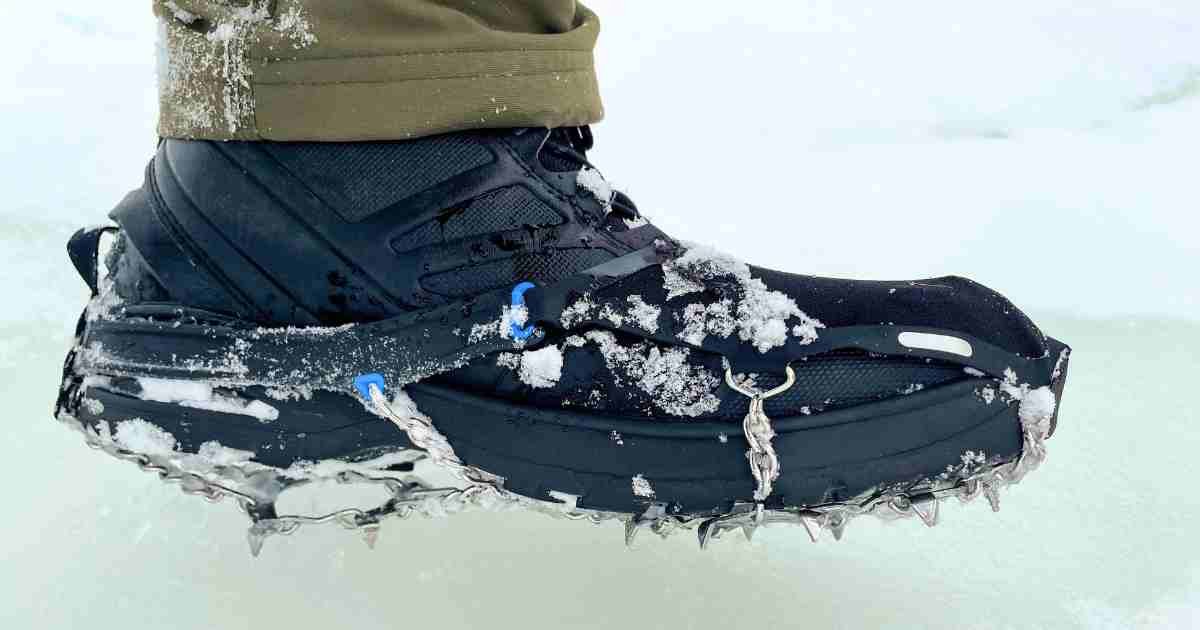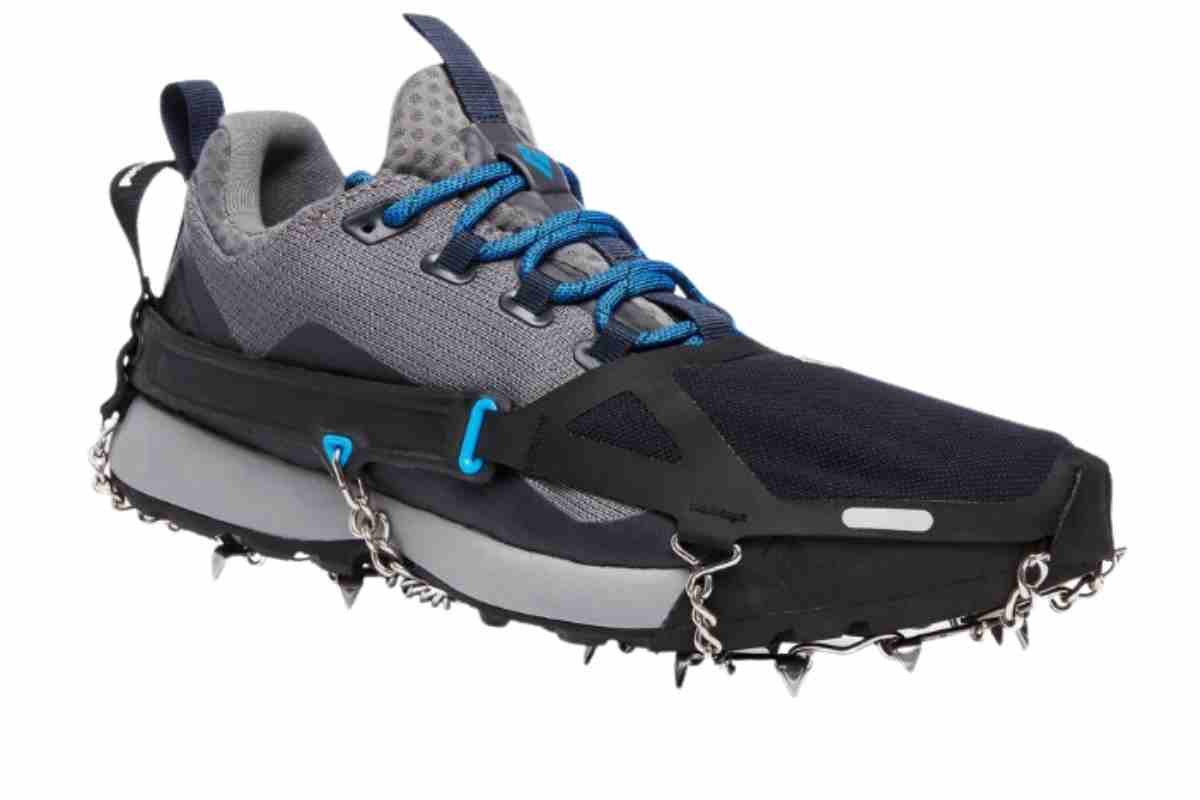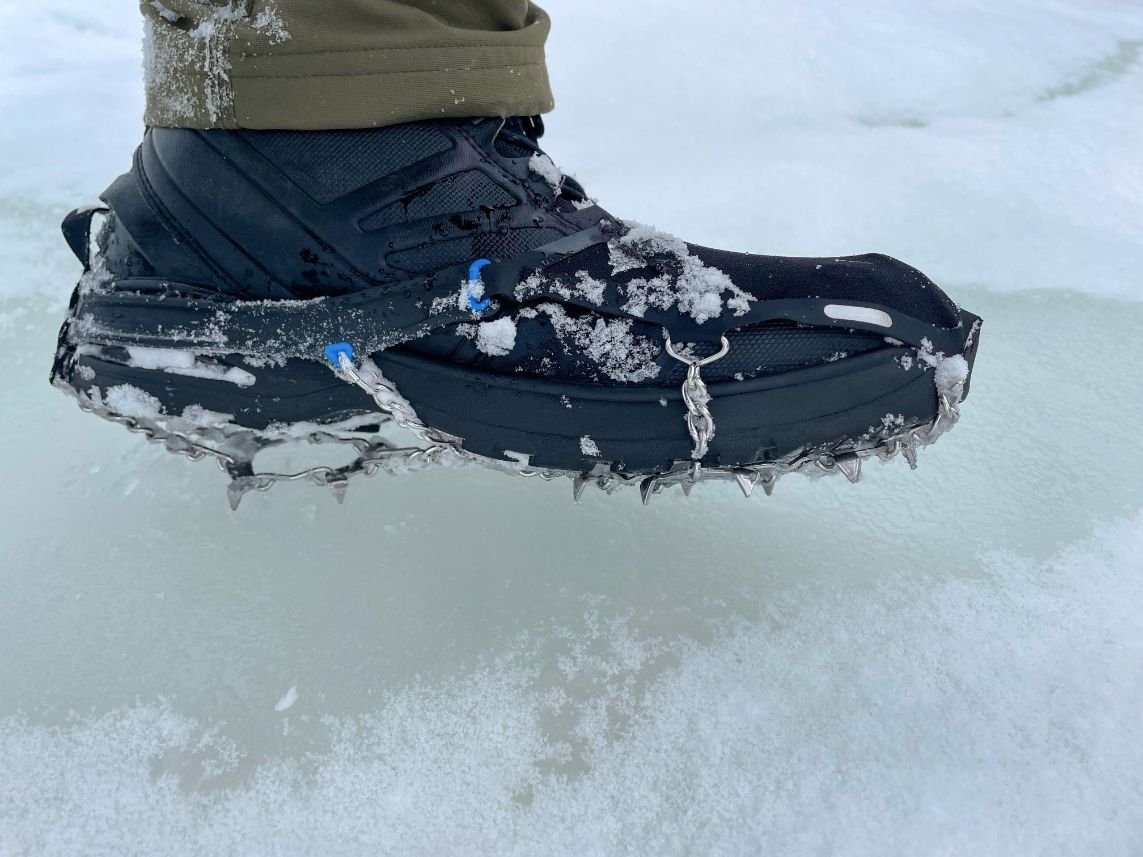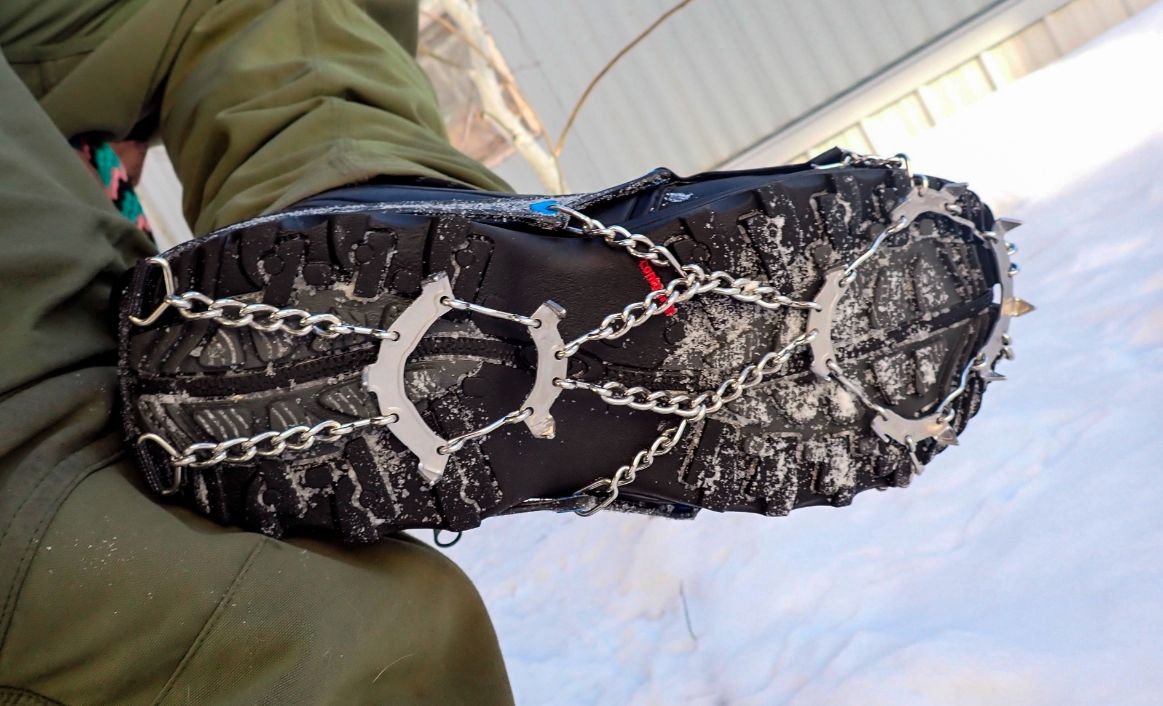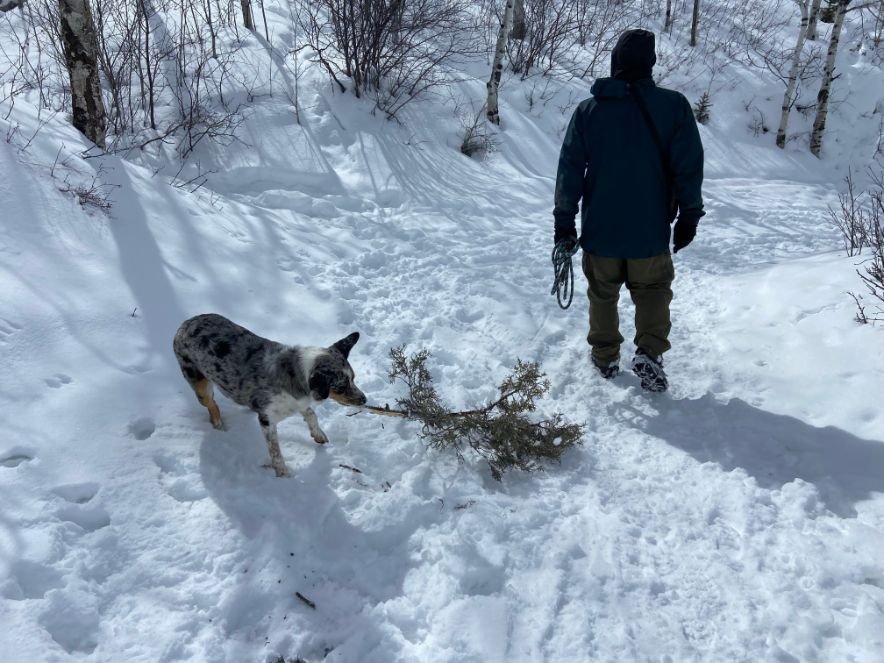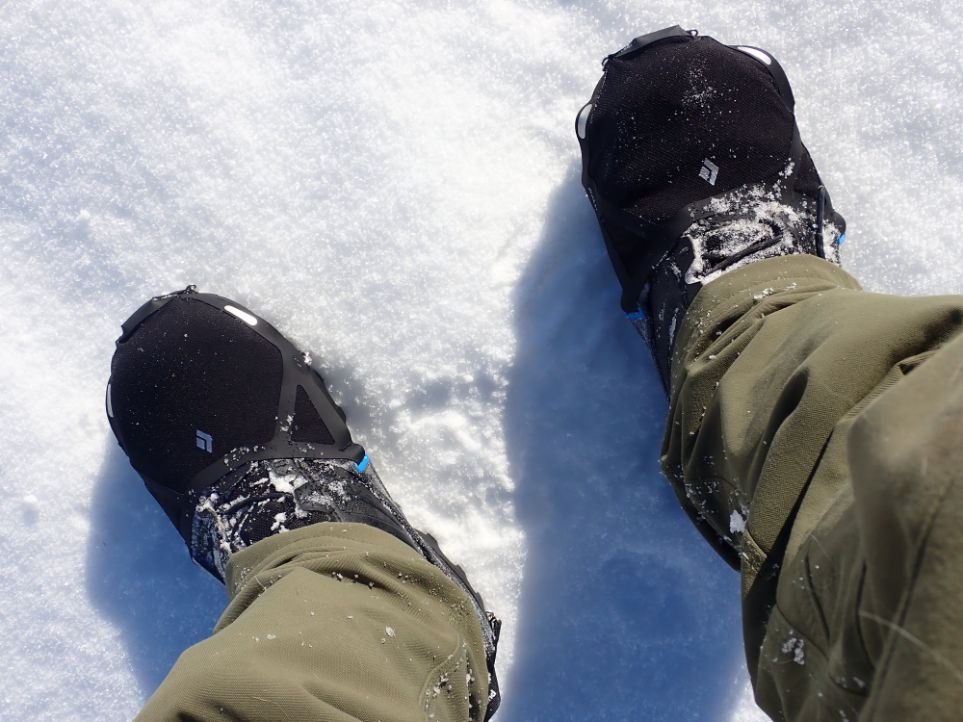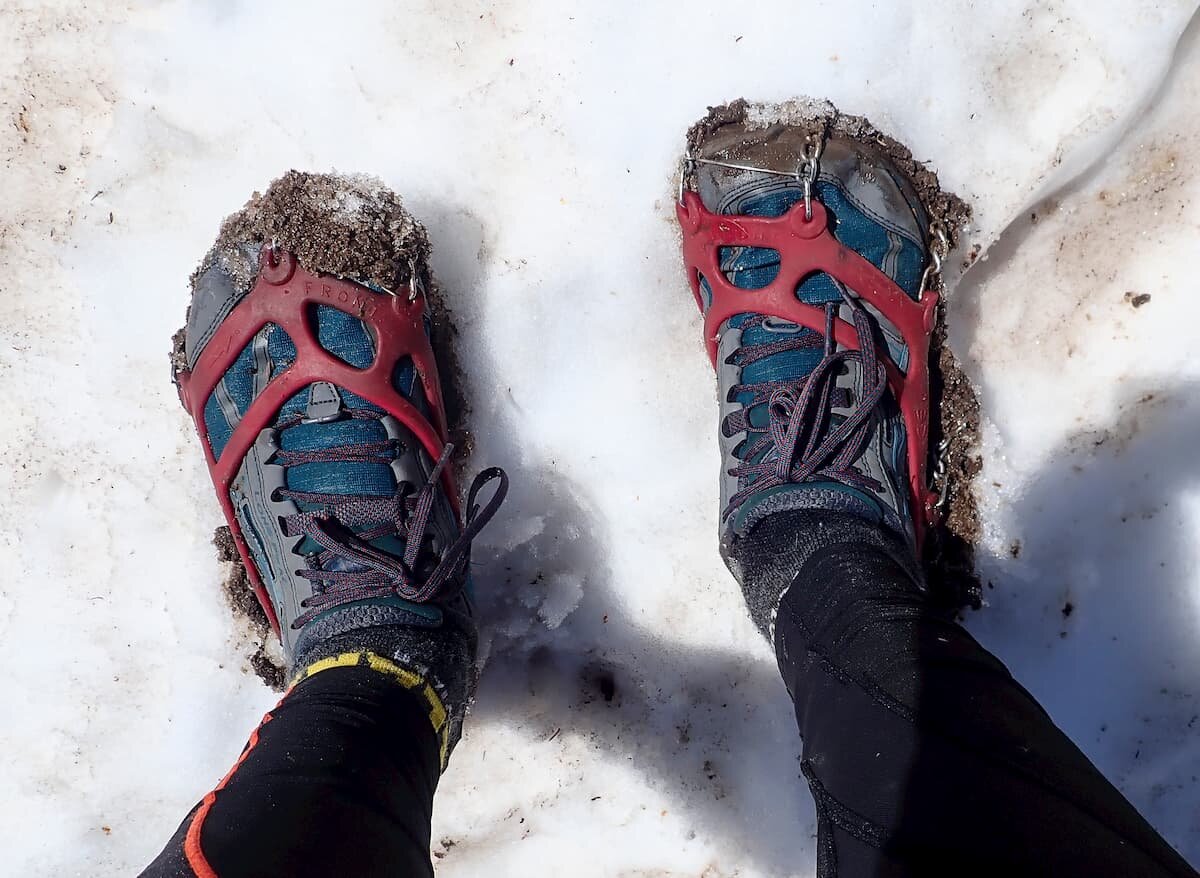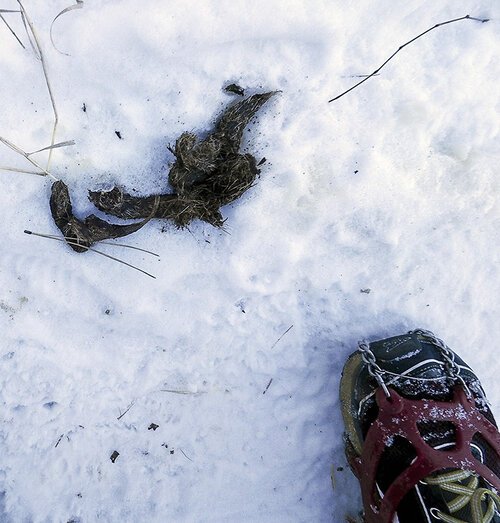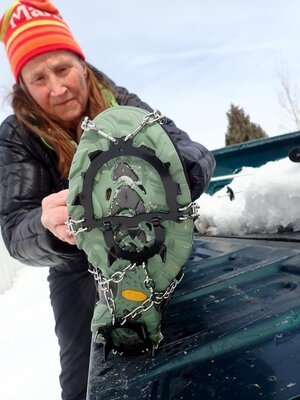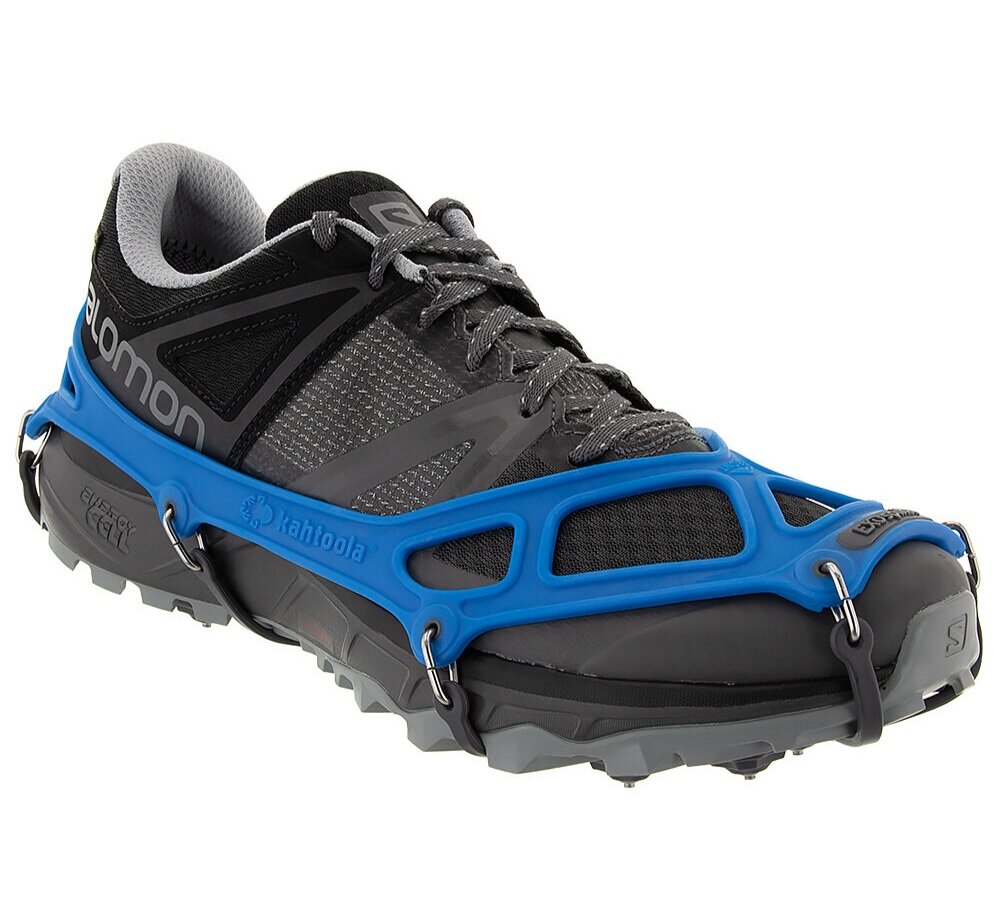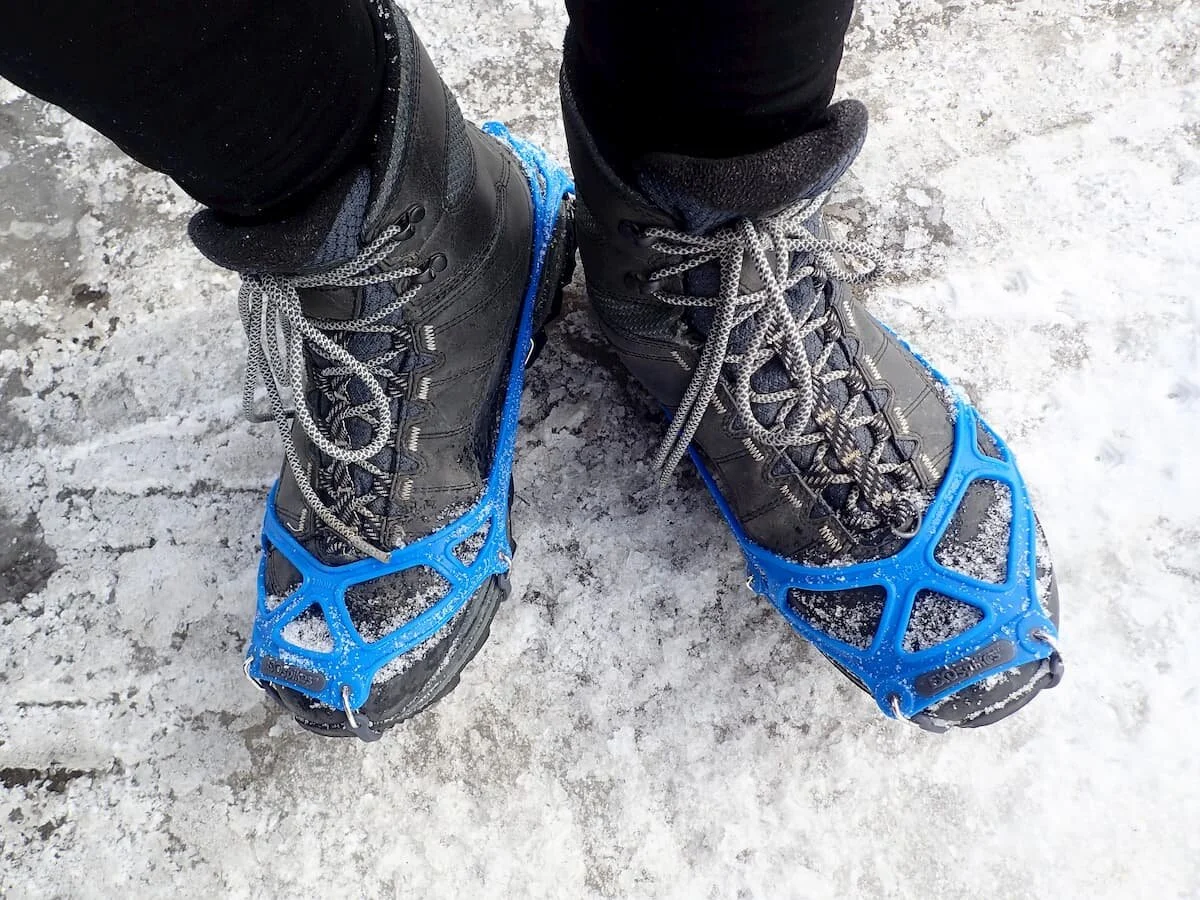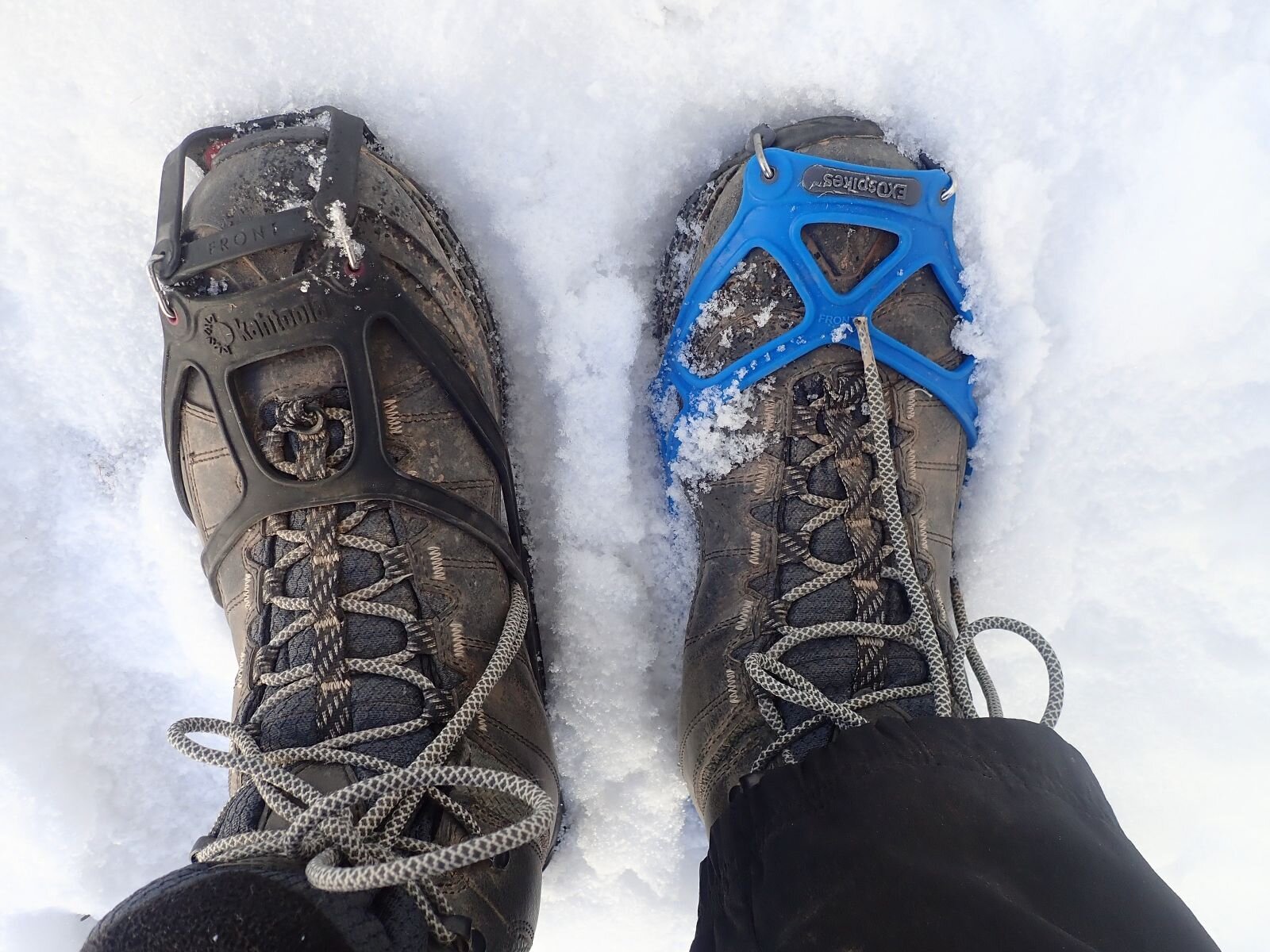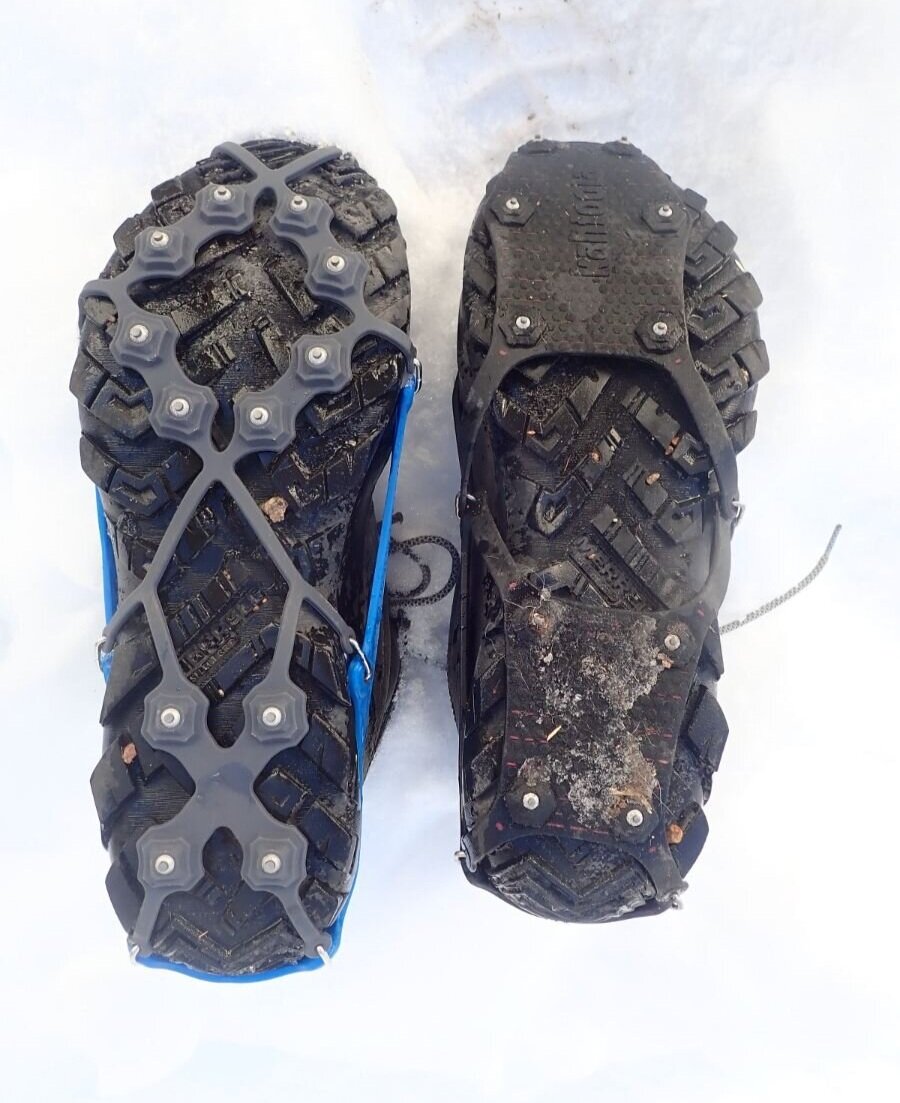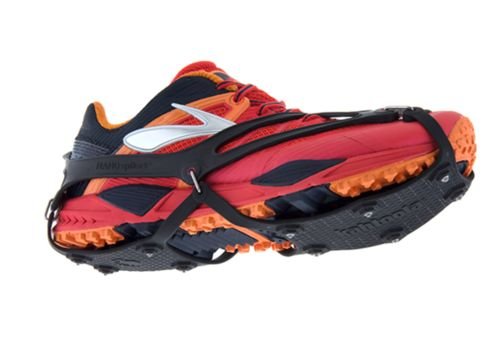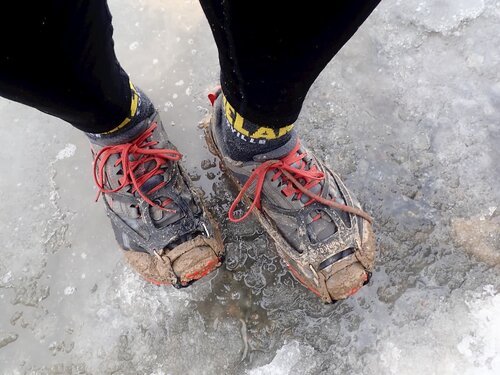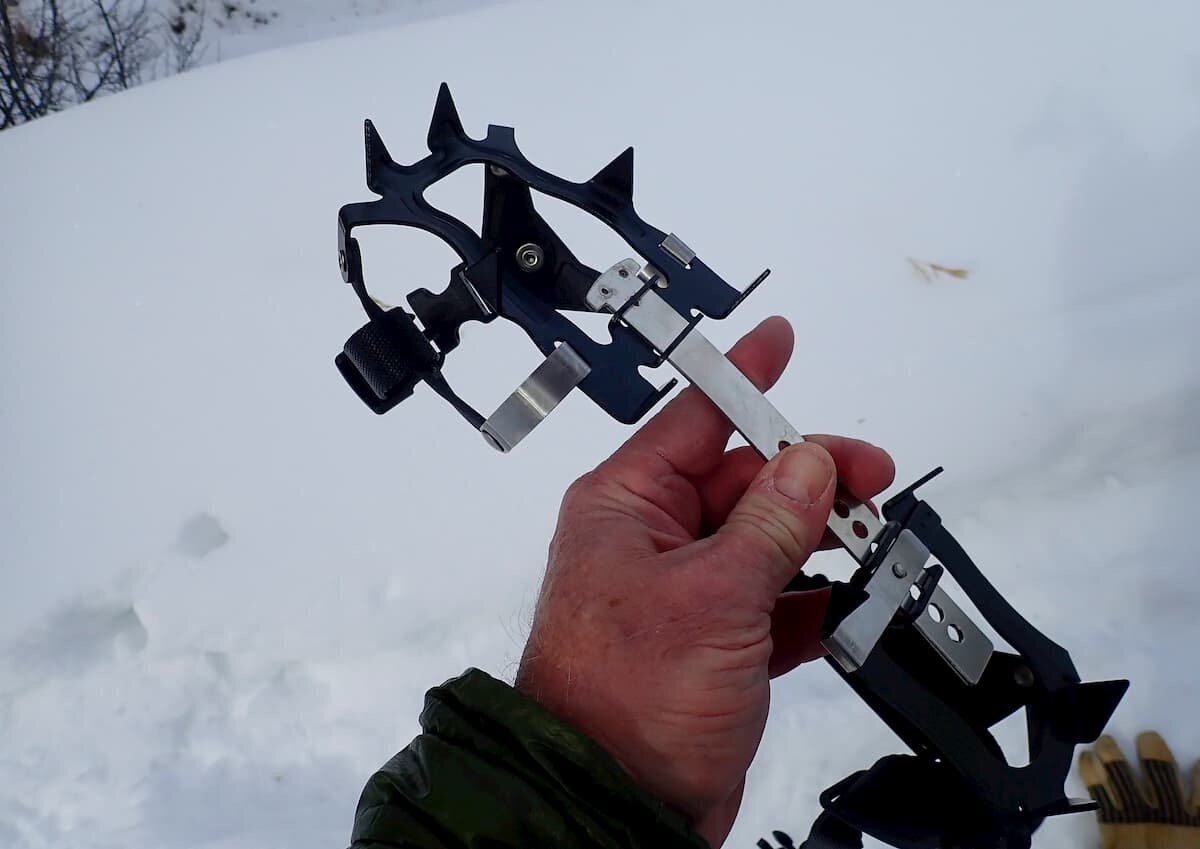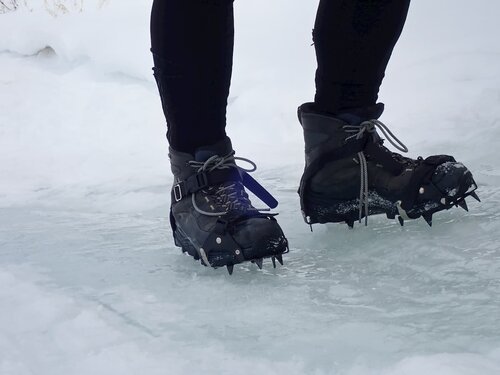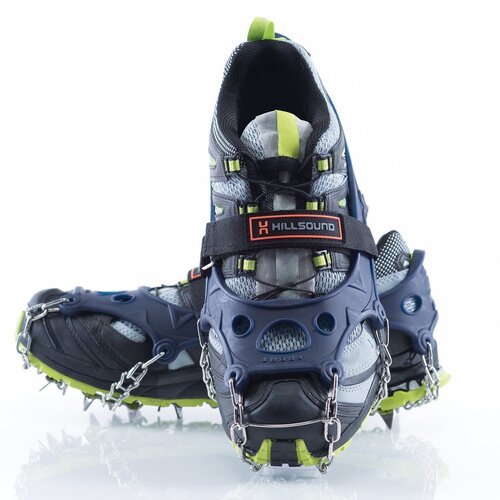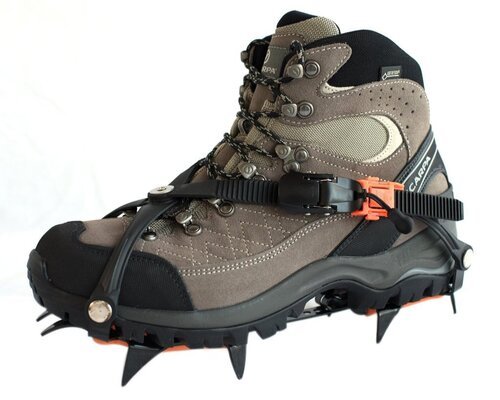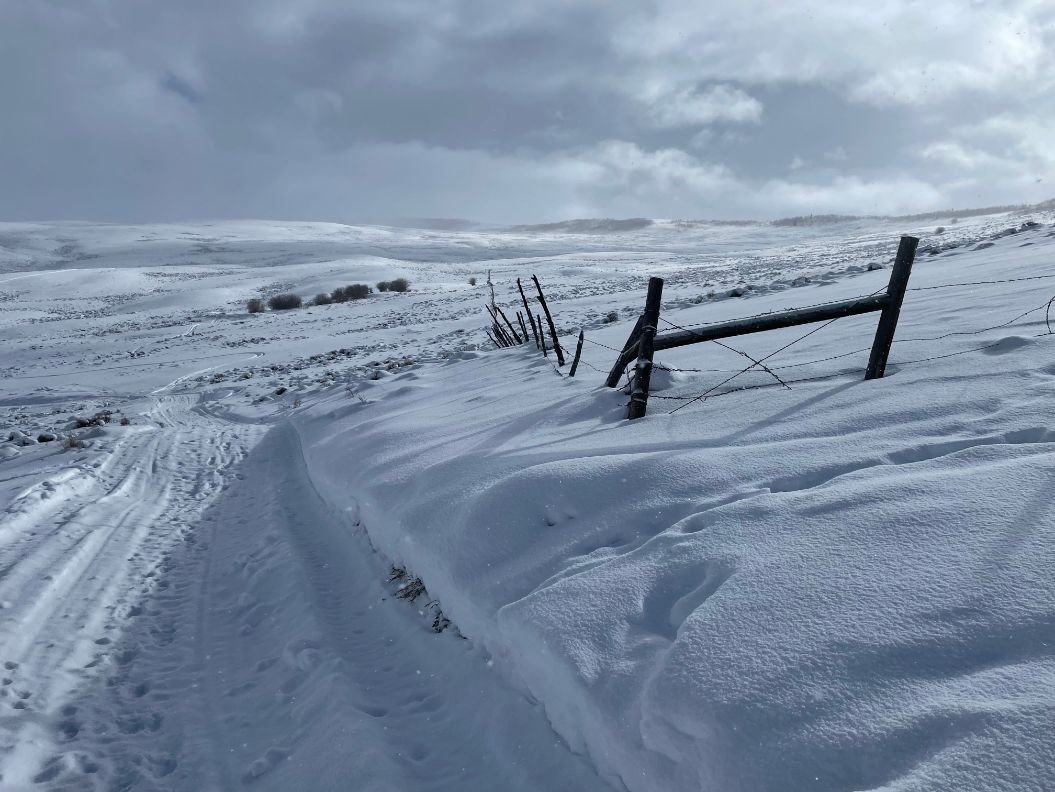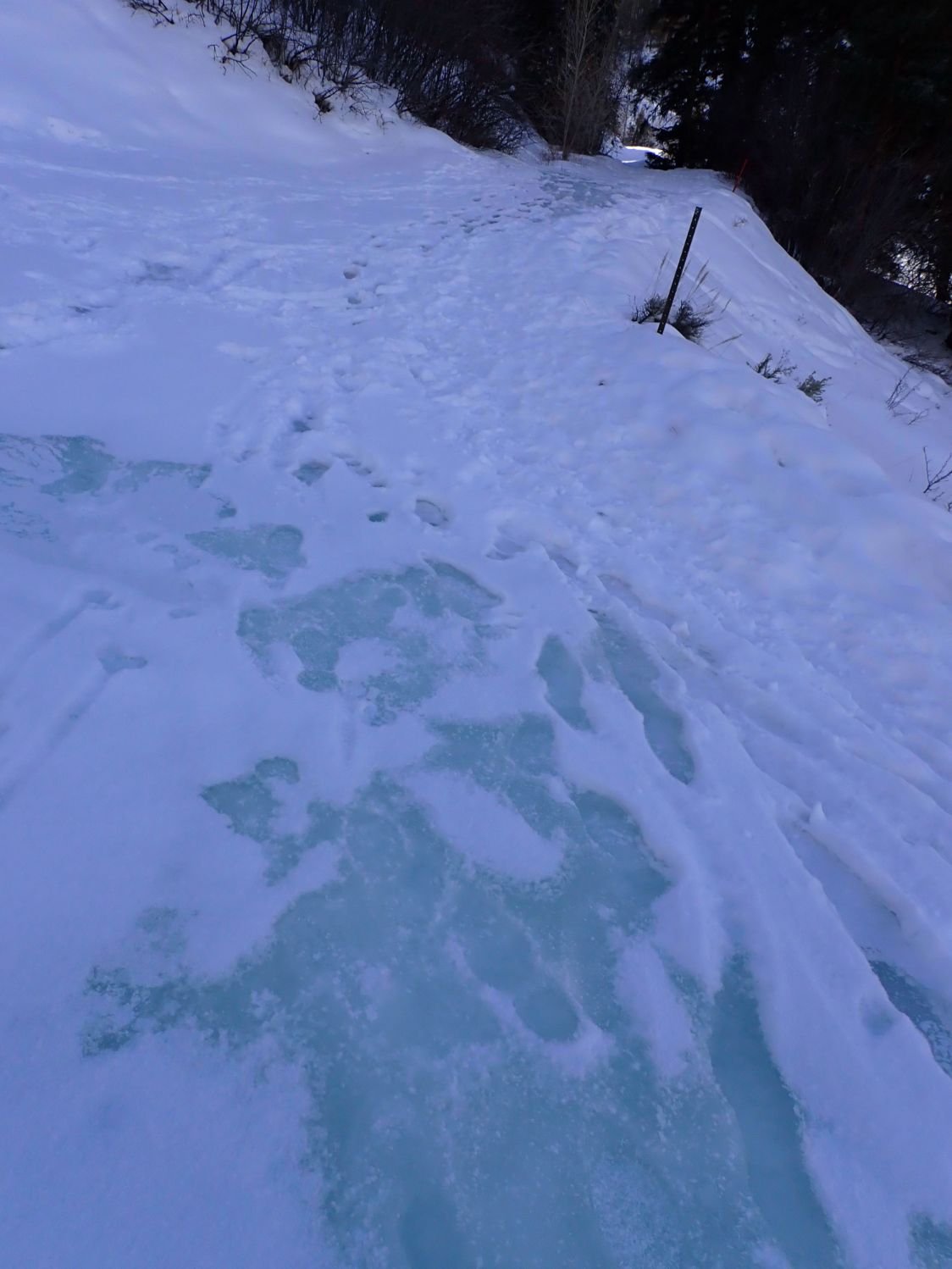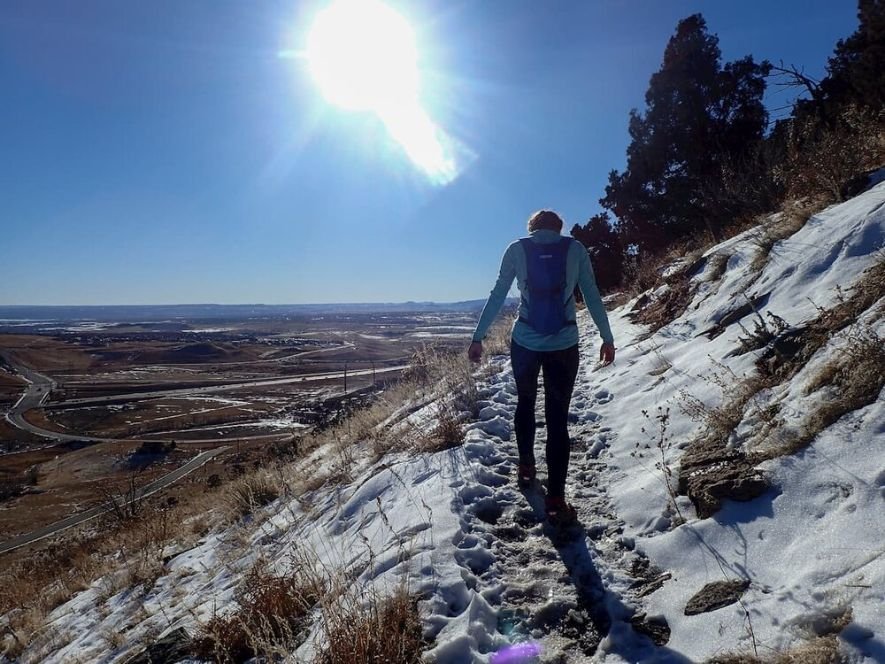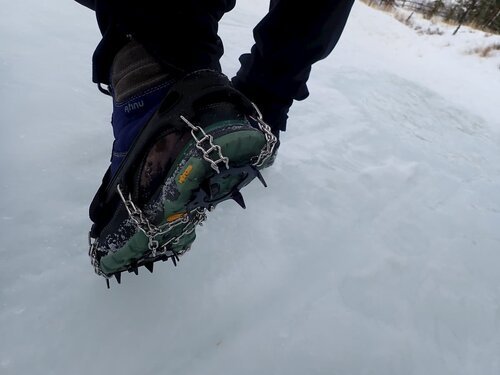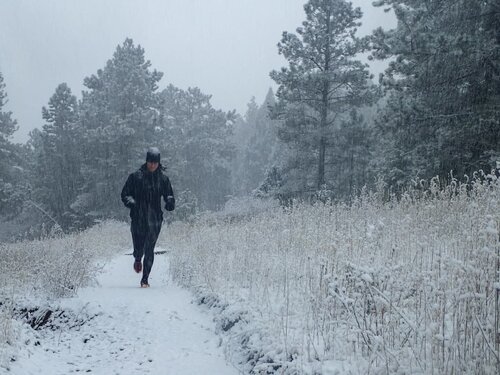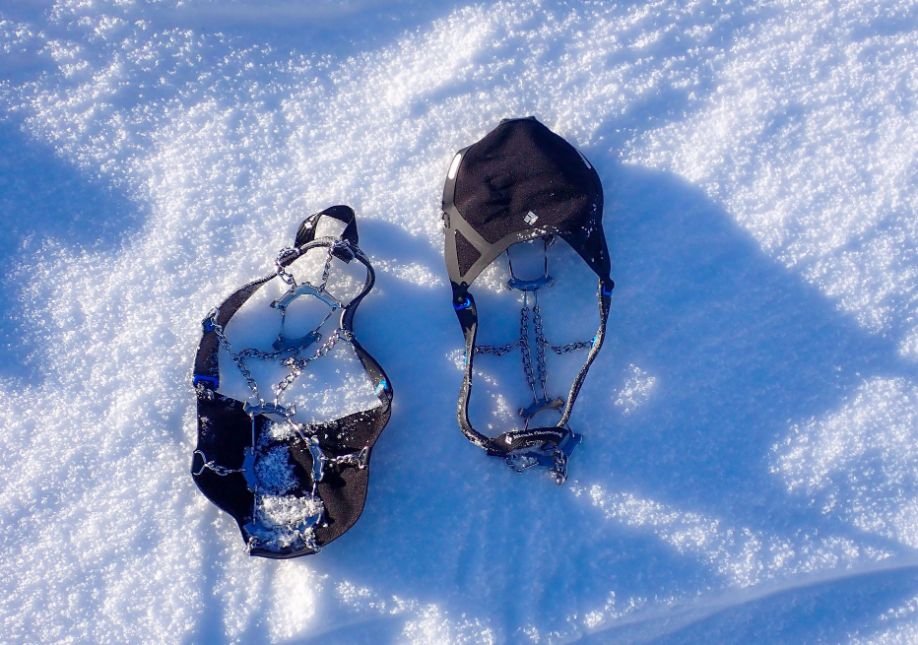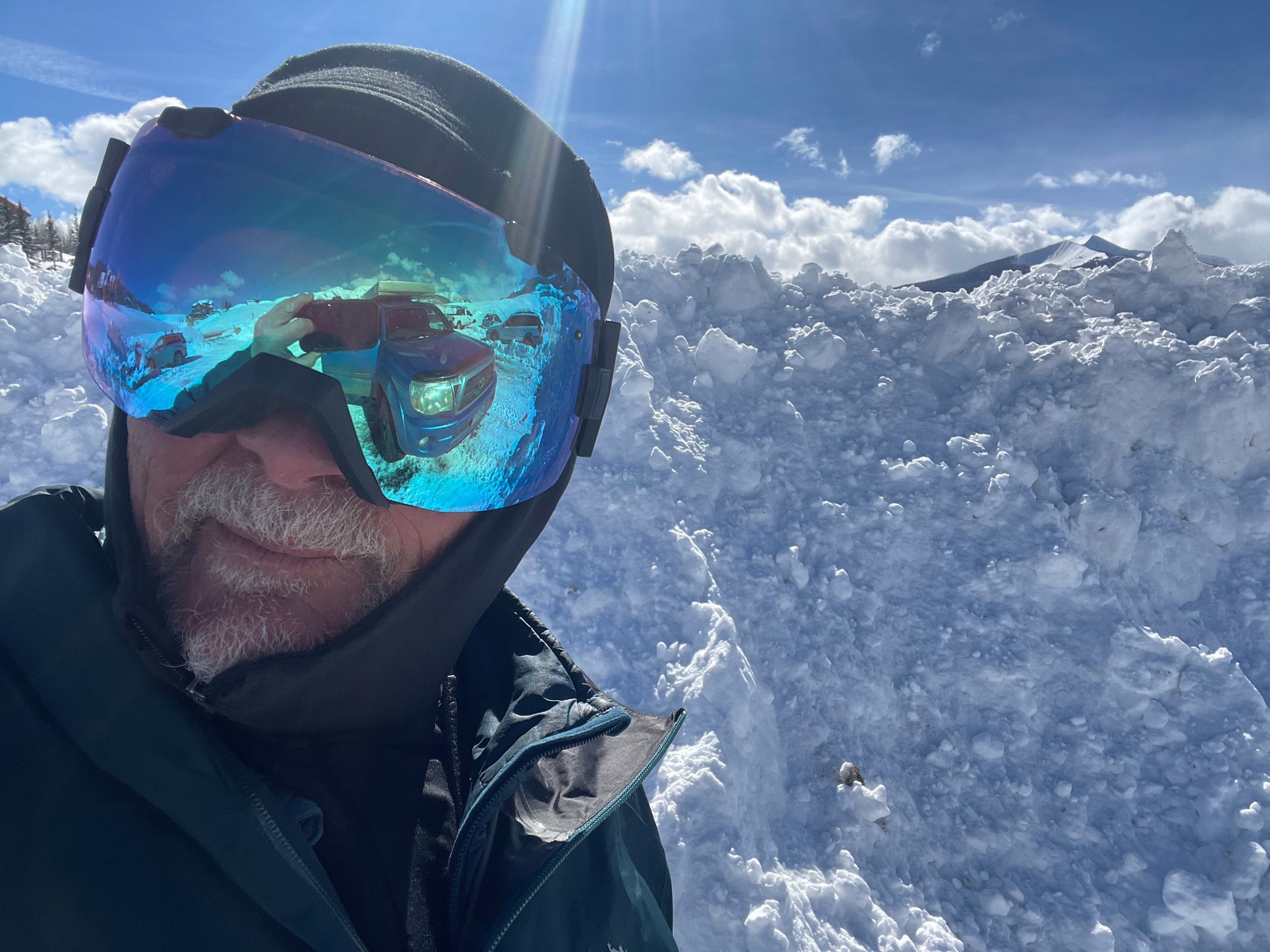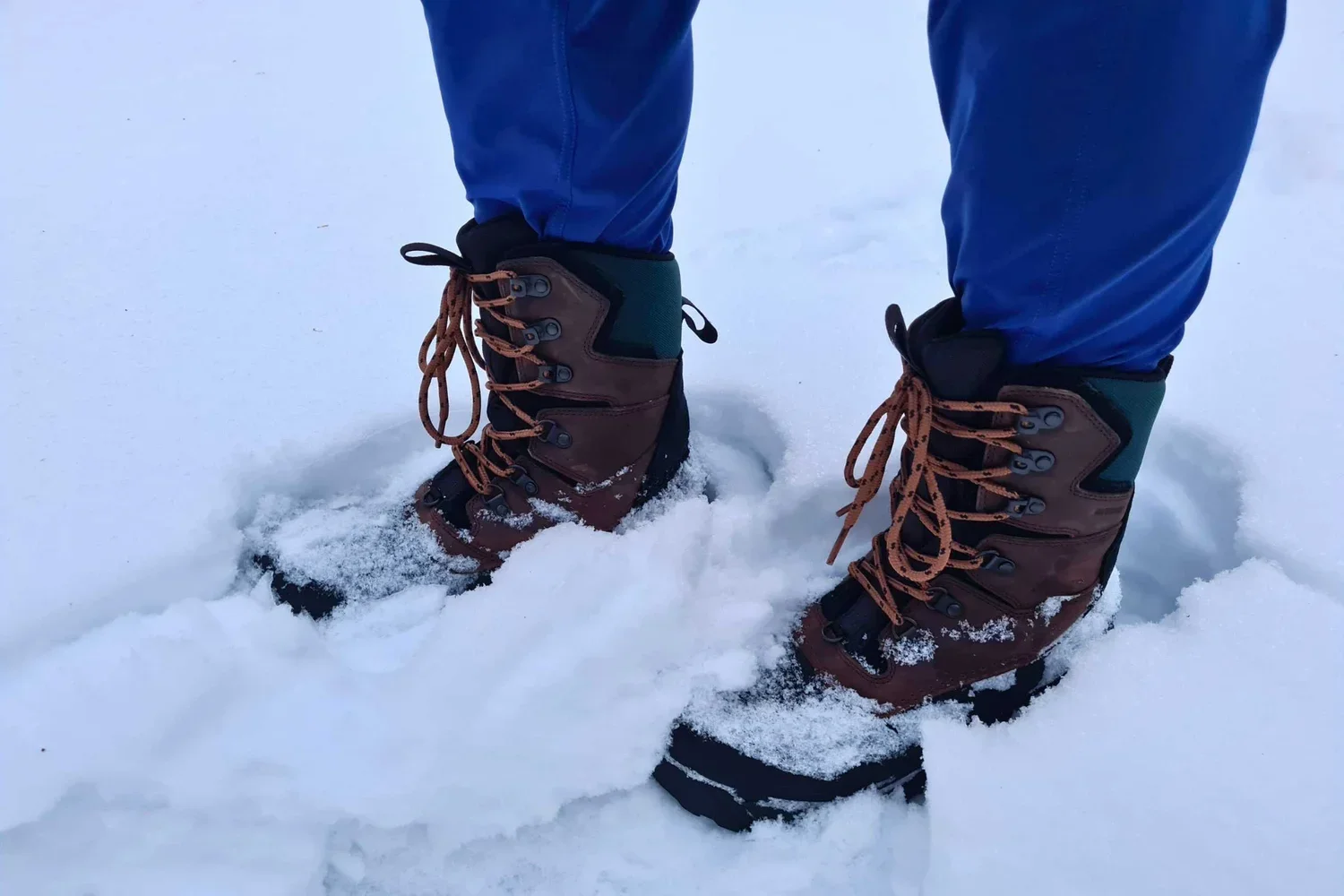Best Winter Traction Devices of 2025 (MICROspikes and Crampons)
Ice Cleats and Winter Traction For Shoes and Boots, Including Kahtoola Microspikes, Hillsound Trail Crampons, And Yaktrax
Published November 11th, 2024
Home > Gear Reviews > Ski & Snow
The best winter ice traction devices do more than just help you stay upright while shoveling snow or navigating the grocery store parking lot.
Sure-footed traction in snow and ice allows you to carry your outdoor life into the shoulder seasons and beyond. Ice cleats help you get across steep snowfields and run in all kinds of inclement conditions.
Winter traction for boots turns icy hikes into serene walks — instead of sketchy dances with slick patches.
In Crested Butte, Colorado, where I reside, some form of frozen water covers the ground for 5 months of the year. Wearing ice grippers on my feet is a way of life.
I field-tested nine of the most popular models and found the best winter traction devices for most kinds of outdoor (and urban) adventures.
We write mission-driven gear reviews. We combine expert reviews, everyday user opinions, and rigorous independent trail testing to find the best gear—never native ads or sponsored posts. We are 100% reader-supported and may make a small commission from some qualifying affiliate links. Learn more.
Comparison Table
We judged the most popular ice cleats side-by-side. This comparison table shows how each model did comparatively on the criteria that most users found important.
| WINTER TRACTION DEVICE | TREELINE AWARD | MSRP* | WEIGHT (PAIR) | NUMBER OF SPIKES | LENGTH OF SPIKES | SPIKE MATERIAL |
|---|---|---|---|---|---|---|
| Black Diamond Distance | Best Overall Read review |
$100 | 7.8 (221 g) | 14 per foot | 0.31" | Stainless steel |
| Kahtoola MICROspikes | Best for Hiking Read review |
$75 | 11.0 oz (312 g) | 12 per foot | 0.38" | Heat-treated 400 series stainless steel |
| Hillsound Trail Crampon | Best for Backpacking Read review |
$85 | 15.7 oz (445 g) | 11 per foot | 0.66" | Stainless steel |
| Kahtoola EXOspikes | Best for Winter Running Read review |
$65 | 7.3 oz (206 g) | 12 per foot | 0.29" | Tungsten carbide |
| Kahtoola NANOspikes | Best for Urban Use Read review |
$55 | 7.6 oz (215 g) | 10 per foot | 0.21" | Tungsten carbon |
| Kahtoola K 10 Hiking Crampons | Best Non-Technical Mountaineering Read review |
$120 | 23.6 oz (608 g) | 10 per foot | 0.75" | 4130 Chromoly Steel |
*We note any discounts we see on our Deals page, which is updated daily.
The Best Winter Traction Devices
Best Winter Traction Device: Black Diamond Distance Spike Traction Device
Weight per pair: 7.8 oz (220 g) size M
Number of spikes: 14 spikes per foot (on all sizes)
Length of spikes: 0.3 inch spike length (8 mm)
Spike material: hardened stainless steel
What we liked: Lightweight but durable construction, very easy to put on, neoprene adds warmth and waterproofing and aids packing, spikes are good length for versatility (driving, riding a fat tire bike, running, hiking, mud, dirt)
What we didn’t like: More expensive than similar models, Smaller spike not suited for steep ice, did not excel at deep loose snow
The Black Diamond Distance Spike Traction Device features an innovative thin neoprene top cover that fits over the shoe’s toe. The cover aids in putting the Distance spikes on-there’s no confusion about top and bottom or front and back, which has sometimes happened to me-and it adds a small layer of waterproofing and warmth, very welcome on the chilly wet trail days. The soft cover also helps when packing the spikes as the entire spike can be rolled into the cover. Additionally the toe cover helps the Distance stay lightweight.
Initially I thought the Distance too light, the spikes too small and the neoprene cover too flimsy. But after almost daily use during a hard winter I found those same qualities to be assets. I grew to love how light the Distance is, how easy they are to take on and off and how the neoprene cover simplified that process as well as keeping my toes dry and slightly warmer.
This is why after careful consideration, the Black Diamond Distance replaces the Kahtoola MICROspike (review below) as our number one choice for hikers and trail runners who need a dependable traction device that fills the needs in most situations. After 1.5 years of multiple testers' feedback, we stand by this assessment.
Compare Prices On The Black Diamond Distance Spike Traction Device
The Black Diamond Distance traction device features 14 8mm stainless steel spikes, an elastomer harness and a thin neoprene toe cover, weighing 8oz per pair, size large. Photo by Dean Krakel
However, if I had to walk a gnarly, icy ridge or travel across hard or steeply inclined ice for any lengthy distance I would definitely have the Kathoolas in my kit, which is why you’ll still seem them win our award for Best Traction for Hiking.
Black Diamond has been making technical mountain climbing hardware since its early beginnings as Chouinard Equipment, founded by the legendary climber Yvon Chouinard in 1965.
Although Black Diamond has 8 models of crampons in its snow and ice climbing lineup, it only recently produced a pair of lightweight spiked traction devices specifically designed for runners and hikers: the Distance.
Along with a thin, light elastomer harness, the Distance features 14 8mm long heat-treated stainless steel spikes for traction. The spikes are short enough that I had no trouble driving or riding my flat-pedaled fat bike with them on but long enough to give traction in a number of varying conditions. Over the course of the winter, I wore the Distance ice cleats in powder snow, hardpack snow, deep snow, shallow snow, ice, slush, mud, dirt, and rock.
The Black Diamond Distance traction device features 14 8mm stainless steel spikes, an elastomer harness and a thin neoprene toe cover, weighing 8oz per pair, size large. Photo by Dean Krakel
The Distance performed admirably well in most of those conditions, so much so that I found myself preferring it to my usual reliance on our top rated Kahtoola MICROspike. I liked the light weight, the easy on and off and the toe cover. I also liked that the small spikes on the Distance gave me more security than the small carbon points on the Kahtoola NANO and EXO spikes.
The author, Dean Krakel, walks a trail using the Black Diamond Distance traction device while his puppy, Pelli, (short for Kokopelli) does some trail maintenance. Photo by Laine Walter
Where the Distance didn’t perform well was in deeper loose snow and steeper hard ice. Although those are tough conditions for any ice grippers, the Distance just couldn’t seem to find traction in deeper snow, and I didn’t trust the smaller spikes on steep ice. In those conditions, I returned to using the beefier Kahtoola MICROspike.
The Black Diamond Distance traction device features a thin neoprene toe cover, which adds warmth and makes it easier to take on and off. Photo by Dean Krakel
The Distance weighs 8 ounces per pair in a size large. In comparison, the Kahtoola MICROspike weighs 12.75 ounces per pair, the Kahtoola NANOspike weighs 8.3 ounces, and the Kathoola EXOspike weighs 7.8 ounces (all in size large). When comparing the three by weight, the Distance feels closest to the MICROspike but weighs as much as the lightweight EXOspike.
Best winter traction for hiking: Kahtoola microspikes
Weight per pair: 11 oz (312 g) size M
Number of spikes: 12 spikes per foot (on all sizes)
Length of spikes: 3/8-inch spike length (1 cm)
Spike material: hardened stainless steel
What we liked: Lightweight but durable construction. Best balance of mixed terrain performance. Better price than similar models.
What we didn’t like: May need some minor adjustments during outings depending on fit over particular shoes
I’ve used a pair of Kahtoola MICROspikes — the same pair of Kahtoola spikes — for a decade. I’ve worn them in all kinds of conditions: icy city sidewalks, snowy trail runs, steep mixed mud, ice backpacking ascents, and descents off mountain passes. They shine on ice and snow on trails, as well as on city streets, too. They’re durable, comfortable, easy to use, and lightweight, and they’re simply the best we tested.
Through all that use, the MICROspikes never failed me. But alas, after ten years, the elastomer has finally worn out and has to be frequently patched together with wire. My search for a replacement pair of spikes led to this review.
Kathoola was the first company to take backcountry traction for hikers seriously. (Mountaineering-focused manufacturers have been making backcountry traction for decades). MICROspikes have won Backpacker Magazine’s Hall of Fame and Editors’ Choice Gold Award.
Compare Prices Of Kahtoola Microspikes
The author wearing a pair of MICROspikes on the trail. Photo by Dean Krakel.
MICROspikes feature a stretchy elastomer harness that attaches the spikes to your shoe. This makes them easy and fast to slip on and off and works with various shoe shapes and sizes.
Although MICROspikes have been around for more than a decade, a design change allowed Kathoola to lower the profile and weight of their elastomer. They also reinforced the harness attachment points to the metal chains holding the spikes in place.
The newest version of the MICROspikes does have a lower profile and stretchier elastomer band than older versions.
The band feels more solid than the band in my old pair, but that may be just attributed to stretch due to wear.
The MICROspikes are among the lightest trail crampons we reviewed. Although YakTrax and Black Diamond make lighter-weight traction devices, they don’t perform as well as a full set of spikes and don’t have the same traction ability.
In short, MICROspikes work well on trail running shoes and hiking boots and insulated boots. Their versatility and ease of use are why we think they’re the Best Ice Traction Device for Hiking.
MICROspikes have 12 ⅜-inch stainless steel spikes attached to steel plates under your foot, integrated in a way that helps prevent snow from compacting between the spikes and the shoe bottom. Despite this, nearly all trail traction devices, including the Kahtoolas, will ball up under the right conditions with wet snow and mud.
I’ve found that MICROspikes work well in mixed terrain. They work well on ice and snow and decently on rock and pavement. There are better options for thick ice and less slick options for rock or pavement, but the MICROspikes hit the sweet spot of performing decently on all.
The Kahtoola MICROspikes take you to wild places. Photo by Dean Krakel.
Several reviewers noted that MICROspikes sometimes had to be adjusted during the course of a run or hike. I’ve certainly noted that binding slippage in my own use. MICROspikes do not have the velcro strap to help keep them snug on your shoe, as do the Hillsound Trail Crampons (our backpacking pick).
As with all trail spikes, the fit is key when sizing. They need to be tight enough to stay in place but not so tight they can’t be pulled onto your shoe in cold weather with gloved hands. See our How to Size an Ice Traction Device section for our tips on telling when a spike fits correctly.
Another downside with the MICROspikes is that they can sometimes slip to the left or right of your shoe and become crooked. Kahtoola claims that this can be fixed through better sizing of your spikes, but our spikes are pretty tight, and we don’t think sizing down more is really an option. Additionally, because they lack the strap across the instep found on the Hillsound spikes, the Kahtoola are more likely to get lost in post-holing in snow or deep mud when on mixed terrain.
One thing to keep in mind with the Kahtoola MICROspikes is there’s confusion about the top and bottom or front and back. This wasn’t the case with the Black Diamond Distance. The Kahtoola also lack the Neoprene toe cap we liked in the Distance, which adds a small layer of waterproofing and warmth. We found we missed that feature on the Kahtoola.
Still, we think that the Kahtoola MICROspikes are the best bet for most people for most uses. They provide durability, quality traction, and reliability — all at an affordable price.
Best Ice Traction for Backpacking and Hiking: Hillsound trail crampon
Weight (pair): 15.7 oz | 445 g
Spike material: Carbon steel
Spike length: 2/3 inch | 1.7 cm
Number of spikes: 11 per foot
Chain material: Stainless steel
What we liked: The velcro strap adds lots of security. Aggressive spikes for more serious terrain
What we didn’t like: Not the best pick for more casual use
What we and other reviewers liked about the Hillsound Trail Crampon is the velcro strap across the top of the instep. The Hillsound Trail Crampon (and other Hillsound traction devices) are the most secure-feeling ice grippers we considered. It helps hold the crampon securely in place, a common issue with ice grippers. Anyone who’s ever had their crampons or spikes sucked off a shoe by mud or deep snow can appreciate this feature.
Sometimes, little things like that, the addition of a simple velcro strap, makes a huge difference in performance. That’s why we give the HillSound Trail Crampon our Best Backpacking Ice Traction Device award.
Compare Prices Of The Hillsound Trail Crampons
Putting the Hillsound Trail Crampon on. Photo by Dean Krakel.
The Hillsound Trail Crampon also gets high marks for its sturdy stainless steel build. It includes a plate system underfoot that holds the 11 carbon steel ⅔” spikes in place. A ⅔” long spike is a serious spike, meant for serious trail work.
The Trail Crampon’s elastomer harness also fits lightweight and heavier hiking and insulated boots. The Trail Crampon won’t work as well on trail runners or street kicks, but it’s doubtful you’d want to take these 1-pound-plus beasts with their long spikes on a trail run or clomp to work in them.
Again, this is one reason we think the Hillsound Trail Crampons are best for backpacking or hiking. When backpacking or hiking, you’re most likely to wear hiking boots or insulated winter boots and want burly enough spikes to work with your footwear.
Although the Hillsound Trail Crampons can be worn with lightweight trail running shoes, we suggest that if you’re using a lighter-weight shoe, you may be happier with a lighter-weight spike (like the Kahtoola MICROspikes in our review above). We tried the Hillsound with our trail runners, and while they work, we think the lighter-weight Kahtoola MICROspikes work better with running shoes.
The strap on the Hillsound Trail Crampon makes the system extra secure. Photo by Dean Krakel.
Still, we were impressed by how well the Trail Crampon works in all kinds of snowy and icy conditions. Like other trail crampons, the Hillsound can occasionally ball up with compacted snow, which could cause a loss of traction. Check those spikes! We had to manually remove ice balls from the spikes to maintain traction.
Although you can hike in mixed terrain with the Hillsound Trail Crampon, it works best in the snow and ice it’s meant for.
Another perk: Like all the Hillsounds we reviewed, the Trail Crampon comes with a 2-year warranty.
For more of our favorite winter gear recommendations, see our most popular Winter Gear Guide stories:
Best Snow and Ice Traction For Winter Running: Kahtoola Exospikes
Weight (pair): 7.3 oz | 207 g (size M)
Number of Spikes: 12
Spike length: 0.29 inch (0.74 cm)
Spike material: Tungsten carbide
Harness: Elastomer
What we liked: Attractive weight, secure elastomer harness around running shoes, versatile for casual use
What we didn’t like: No complaints for what they’re intended for, but you may need more aggressive traction for more mixed terrain pursuits
The Kahtoola EXOspikes snagged the prize for best traction for winter running, unseating our previous winner, the Kahtoola NANOspikes (our review below). After 10 months of testing since February, we think Kahtoola took everything we loved about the NANO and outdid themselves.
I found the EXOspikes to be a significant improvement over my beloved NANOs. The extra-long and more numerous spikes provided improved traction on frozen mud, hard ice, and hardpack snow. The EXOspikes are so light I often forgot I was wearing them. Yet I could still easily drive my car or pedal my fat bike with zero spike hindrance. If you plan to run a mix of roads and trails, the EXOspikes are the best all-terrain running option for ease of use, flexibility, lightness, and grip.
Compare Prices Of The Kahtoola Exospikes
We’ve been testing the Kahtoola EXOspikes since February 2020 in mixed terrain in and around Crested Butte, CO. Photo by Dean Krakel.
Comparison of the elastic on the NANOspikes (left) vs. EXOspikes (right). Photo by Dean Krakel.
The EXOspike is the NANOspike on steroids. As a running ice gripper, we loved three main features on the Kahtoola NANOspike—all of which are found on the EXOspike as well.
1) It's lightweight, bringing along only what you need for a good winter running experience.
2) The stretchy elastomer harness that fits around your shoe is strong and durable, working well with a trail running shoe.
3) Finally, the small, carbide-tipped spikes mounted underfoot in plastic plates allowed smooth, shock-absorbing transitions between slick surfaces, hard pavement, and dry ground.
The EXOspikes have an even better grip than last year’s winners, the NANOspikes. EXOspikes have 12 tungsten carbide tips per foot versus 10 in the NANOspike. Each of the EXOspikes’ carbon-tipped teeth is 0.29 inches in length versus the NANOspikes’ 0.21 inches in length.
Kahtoola also lightened the EXOspikes. A pair of EXOspikes (size XL) weighs a scant 8 ounces compared to the NANOspike’s 9 ounces for the same size.
The elastomer harness that attaches EXOspikes to your shoe is also an improvement over the NANOspikes. It’s both stronger and better fitting with a design that allows for easier on and off.
Comparison of the spikes on the EXO (left) and NANO (right). Photo by Dean Krakel.
An extra bonus for runners is that the carbide points and aluminum housing act along with the plastic plate to absorb shock as you run. The plates fit tightly against the shoe bottom, preventing snow or mud build-up underfoot. The harness on the EXOspikes will wear out long before the tungsten carbon points. This shock absorption is also a feature found on the NANOspikes.
EXOspikes’ spikes are mounted in what Kahtoola calls a “TPU traction matrix”—a complicated way of saying the EXO’s spikes are mounted right into the rubbery compound underfoot, not embedded in plastic plates like on the NANO or chains like on the MICROspikes. This decreases the EXO’s weight. In my own testing experience, it also doesn't allow mud and snow to build up between the spikes and boot sole, which sometimes happens between the plastic plates and the bottom of my shoe with my NANOspikes.
The only reason to choose NANOspikes over EXOspikes would be if you were only headed out in an urban environment. NANOspikes, with their smaller and less numerous spikes and underfoot plates, work better for urban running (and walking) situations where the day’s mix might be ice, snow patches, pavement, sidewalks, and parking lots.
EXOspikes excel at winter running because they work well in a wintery urban and trail environment. I have no problem taking mine from slick trails to slick pavement. EXOs are also at home in icier, snowier, steeper, slicker winter mountain conditions. These puppies were born to run (or walk) winter trails. If you’re planning a mix of frontcountry and backcountry activities, the EXOspikes are your best bet.
EXOspikes come in sizes ranging from S-XL, and the harness comes in two colors — blue and black. The spikes have a 2-year warranty. A carrying bag is included.
Check out our Tips for Running in the Winter and Best Running Accessories guides for more on making the most of your cold-weather runs.
Best Snow and Ice Traction For City Use: Kahtoola Nanospikes
Weight (pair): 8 oz | 227 g (size M)
Number of Spikes: 10
Spike length: 0.21” / .53 cm
Spike material: Tungsten carbide
Harness: Elastomer
What we liked: Low profile, lightweight traction boost for icy pavement and concrete
What we didn’t like: Slick on linoleum, and some people may prefer more aggressive traction
The Kahtoola NANOspikes are so light — 9 ounces per pair for a size large — that testers hardly noticed them underfoot when running on icy roads and streets. NANOspikes are a lighter version of Kahtoola’s MICROspikes (review above). Testers liked that the small spikes, closer to being cleats, allowed the NANOspikes to make smooth transitions between running on slick surfaces, dry pavement, and ground.
In my testing and daily use of the NANOs around Crested Butte confirm that the NANOs are an excellent choice for moderate conditions and everyday use. While the new EXOspikes surpass the NANOspikes for running, we think the NANOspikes are still the best option for driveways, city sidewalks, and icy parking lots.
The NANOspikes attach to your shoe using a lighter version of the MICROspikes elastomer harness. NANOspikes have 10 minuscule 0.21-inch long tungsten carbide spikes individually attached to an aluminum anchor spread across the bottom of flexible plastic plates. They’re easy to put on for convenient everyday use.
Compare Prices Of The Kahtoola Nanospikes
The author tests the Nanospikes on ice. Photo by Dean Krakel.
I use the NANOspikes for traction when walking across an icy parking lot or sidewalk. I also use them for walking on a slick driveway or shoveling snow. Virtually any activity that requires lightweight, non-obtrusive surefootedness is the perfect terrain for NANOspikes. A huge perk of these ice traction devices is that the NANOs don’t interfere with driving a car or pedaling a mountain bike.
Living in Crested Butte, Colorado, I rarely leave my front porch without a pair of NANOs on my trail runners or insulated boots. I use them for visiting town or walking around outside my home.
But NANOs do have their limits. As I’ve discovered recently, they tend to be slippery on the linoleum floors of grocery store aisles. Although better than having nothing on your feet, NANOspikes aren’t made for wintry or icy mountain environments where real dig-in traction is needed.
The NANOspikes are best suited to running in urban and pastoral landscapes and excel as a non-obtrusive ice traction device for everyday use. Unlike some crampons, they easily fit over hiking shoes or lower-profile trail running shoes.
Best Non-Technical Mountaineering Crampons: Kahtoola K 10 Hiking Crampons
Weight per pair: 23.6 oz (608 g)
Number of spikes: 10 spikes per foot
Length of spikes: 3/4” / 1.9cm
Spike material: 4131 Chromoly steel
What we liked: Added capability over our other tested options at a small price penalty. SRS plate helps prevent snowballing
What we didn’t like: Use case may be narrow since they aren’t for technical mountaineering or trail running, but something in between
For more hardcore snow and ice hiking, backpacking, and climbing (say you want to stroll around on a glacier), reviewers and our own testers liked the Kathoola K 10. The K 10 combines some of the features of more expensive mountaineering and ice climbing crampons in a lighter, more flexible crampon designed for hikers and backpackers. The K 10s are designed to work in some of the conditions where crampons and a heavier stiff-soled boot may be your only other option, but the K 10s are too aggressive for casual winter hiking or trail running.
Compare Prices Of The Kahtoola K 10 Hiking Crampons
Putting on the Kahtoola K 10s. Photo by Dean Krakel.
The K 10s have ten spikes: eight ¾” Chromoly steel spikes on the bottom of each foot and two front spikes. Most of the spikes are in two rows that are evenly spaced. They are attached to each other along the boot bottom from heel to toe by Kahtoola’s patented LeafSpring Flex Bar. This design feature allows the toe and heel spikes to flex underfoot and yet maintains tension as you walk. The LeafSpring easily adjusts to fit different lengths of hiking shoes and comes with a lifetime guarantee. The K 10’s spikes are set at slightly different angles to provide better contact.
Kahtoola K 10S Vs. Crampons
Some folks find mountaineering and ice climbing crampons can impact their normal gait. In contrast, we didn’t have any issues walking in K 10s and found that we didn't have to change our gait.
K 10s attach to a boot with two sets of independent bindings that snap closed, one around the ankle and the other across the boot front. Although we don’t find these the easiest snap closures to close or open with mittens or winter gloves, these bindings make fitting the K 10 to boots and fine-tuning the fit easy.
The Kahtoola K 10s grip to solid ice and work best with a boot. Photo by Dean Krakel.
One downside we experienced is that snow and ice can build up under the plates and spikes of the K 10, reducing the efficiency of the spikes. To address this issue, a pair of Kahtoola neoprene Snow Release Skins (SRS) comes with the purchase of the K 10. The SRS come with a heel section and a front section for each crampon. There is no right or left SRS. They slip snugly over and around each spike and eliminate the snowballing problem.
Although one tester found fitting the SRS to the K 10s mildly challenging, we had no difficulty attaching them during field tests. If snow starts balling up underfoot while using the K 10s, we found it easy to put the SRS on. However, there are two caveats: 1) the crampons must be free of snow to use the SRS, so it’s best to take them off. 2) it requires some manual dexterity to slip the SRS over the points and stretch them to fit.
The author’s puppy plays with the K 10s in the snow. Photo by Dean Krakel.
We recommend attaching the SRS at home before using them in the snow. We see no reason to keep taking the SRS on and off. Despite the minuscule weight penalty, we prefer just leaving the SRS on all the time. The SRS are best attached from the back of the K 10s to the front. We also recommend practicing putting on and taking off gear at home before heading outside.
This superhero super traction comes with a price — both in weight and cost. The K 10 weighs 21.5 ounces per pair, which is still the lightest steel crampon on the market (but a reminder: they can’t do everything that mountaineering crampons can do). Additionally, their cost is much less than many full crampons. And unlike many ice grippers in this guide, these crampons are something you’re best wearing with full hiking boots instead of a lightweight boot or trail runner.
Other winter traction devices we tested
The Hillsound Trail Crampon Ultra
Weight (pair): 14.1 oz | 400 g (size M)
Number of spikes: 18
Spike length: 1/2" - 2/3" | 1.2 - 1.5 cm
Spike material: Stainless steel
Harness: Elastomer
Hillsound’s Trail Crampon Ultra was a stiff competitor to Kahtoola MICROspikes (review above) for Best All-Around Ice Traction Device category.
The Trail Crampon Ultra is a lighter-weight, 14 oz per pair version of their Hillsound Trail Crampon (our winner for Best Backpacking Ice Traction Device). While the MICROspikes and Trail Crampon Ultras were very close, and both pairs met our criteria, we ultimately found a few concerns with the Ultra that made it our runner-up.
Compare Prices Of The Hillsound Trail Crampon Ultra
Testers found the Ultra formed balled-up snow more frequently than the Kahtoola MICROspikes. Compared to the MICROspikes, the Ultra has longer spikes, which collect more snow underfoot in mushy trail conditions. The Ultra’s longer spikes made traction on hard services like rock and pavement less stable. This makes the Ultra less useful in mixed terrain and late-season snow, where parts of trails can be icy, and some can be muddy. To be clear — snow balling up happens with the MICROspikes as well, but because the Trail Crampon Ultra has more and longer spikes, it can happen more frequently.
Still, there’s a lot to love with the Hillsound Trail Crampon Ultra. The Trail Crampon Ultra fits running shoes as well as hiking and insulated boots. Like the Hillsound Trail Crampon and the Kahtoola MICROspikes, it has an elastomer harness that works with a variety of shoes and foot shapes and sizes.
Our favorite thing about the Trail Crampon Ultra is that, unlike Kahtoola MICROspikes, the Ultra features the same nifty velcro strap across the shoe top as the Trail Crampon. Hillsound’s velcro strap system ensures a snugger fit than some of the other traction devices we tested.
The Trail Crampon Ultra features a welded double chain with flexible metal plates. That plate has fifteen ½” spikes under the front part of the foot and three ⅔” spikes under the heel. When you wear the TC Ultra, this totals to 18 points making contact with slick surfaces.
While the longer spikes can cause more snow to ball up under the spikes, some reviewers liked the longer spikes under the heel for downhill descents. They also appreciate the reduced weight of the Ultra model and increased flexibility over the heavier Hillsound Trail Crampon.
Given how similar the Kahtoola MICROspikes and the Trail Crampon Ultra are, we don’t think you can go wrong with the Trail Crampon Ultra. Indeed, the Trail Crampon Ultra’s only flaw is that it sits somewhere between two other excellent options. Still, we think the snowballing on the spikes and longer spikes make the Ultra less versatile and ultimately make the Kahtoola MICROspikes better for most people.
Similarly, if you know you want something beefier, we think the Hillsound Trail Crampon does a better job. Lastly, the Ultra is more difficult to find, and we didn’t see it available in as many stores. If you wanted to try on or return spikes, we think you’re better off with one of our other picks.
Weight: 11.2 oz / 318 g per pair (size M)
Outer Band: Natural Rubber
Chains and Eyelets: Steel alloy
Cable: Aircraft-grade Steel Cable
Beads: Steel alloy
Yaktrax ICEtrekkers Diamond Grips are more at home in the foothills, on frozen lakes and ponds, and on neighborhood streets and sidewalks than on wintery mountain trails. While Diamond Grips offer solid traction to trail runners and hikers in mixed slick terrain and on hard-packed snow and icy trails, they do not work as well in snow deeper than a few inches or for steep, hard snow or ice. That’s one reason we found the Kahtoola EXOspikes and the Kahtoola Nanospikes better suited for running and everyday use than the otherwise lauded Yaktrax Diamond Grip.
Nothing can cut glass but diamonds, right? Diamond Grips by Yaktrax won’t cut glass, but they will provide solid traction with tiny diamond-shaped beads strung on steel cables. The case-hardened beads swivel independently to bite slick surfaces with hundreds of edges.
I’ve found that Yaktrax Diamond Grips work well on mixed surfaces of rock, gravel, dirt, and pavement. Yaktrax Diamond Grip attaches to all kinds of trail runners, boots, and street shoes with an elastic rubber harness that stays flexible enough for easy on and off even in cold temperatures.
Compare prices of the Yaktrax Icetrekkers Diamond Grip
Yaktrax Diamond Grip vs Kahtoola Microspikes
The Yaktrax ICEtrekkers Diamond Grip are best for casual city use, but that is not to say they can’t be used for mountain recreation. One tester found them perfect for running Colorado trails. One advantage of the Diamond Grip is that they’re available in stores that don’t just specialize in recreational gear, such as Ace Hardware.
Anything that aids grip in the slick is beneficial. But we think that if you need grip in deeper snow, you’d be better served by the Kahtoola MICROspikes (review above) or the Hillsound Trail Crampon (our winner for Best Backpacking Ice Traction Device).
Weight (pair): 667 g | 23.5 oz (R), 704 g | 24.8 oz (XL)
Spike height: 3/4″-1″ | 2 cm-2.6 cm
Number of spikes: 10
Spike material: Carbon steel
Although the Hillsound Trail Crampon Pro and the Kahtoola K 10 (review above) have many similar features, reviewers liked the more flexible and lighter-weight K 10s. The K 10s were also easier to use with flexible soles and easier to walk in. The Hillsound Trail Crampon Pro is an excellent ice traction device for more serious winter adventures, but we think the Kahtoola K 10s better fits most people’s needs for a non-technical mountaineering crampon.
We like that the Trail Crampon Pros have a somewhat similar design to their lighter-weight sibling model, the Trail Crampon (our winner for Best Backpacking Ice Traction Device). But as you would expect with the “Pros” part in its name, the Pros have some additional technical features.
View The Hillsound Trail Crampon Pro
Hillsound Trail Crampon Pro vs. Kahtoola K 10
The Trail Crampon Pro has a lot in common with our Best for Non-Technical Mountaineering Pick, the Kahtoola K 10. They both use ratchet-style bindings. They both have the same number of spikes (ten). Both the TCP and Kahtoola K 10 have ¾-inch long spikes (the same length as the K 10).
The Pro is different because two spikes are one-inch long and front pointing. Front-pointing spikes aid in aggressive uphill climbing. You want front-pointing spikes if you really need to dig in and get a grip on snow and ice. Front pointing spikes are one of those features you find on technical crampons used for mountaineering.
But one difference between technical crampons and the TCPs is the placement of those front-pointing spikes. The TCP’s front-pointing spikes don’t stick out in front of the boot. Instead, they are tucked in under the toe so that you hardly know they’re there until you need them. But while these front points may give you better grip, these front points are not meant for vertical ice climbs. The Trail Crampon Pro isn’t going to replace a dedicated crampon for that use. Nuff said.
The Trail Crampon Pro also has permanently attached rubber and plastic plates to prevent snow packing underfoot. These plates make the Hillsound quite a bit stiffer and less suitable for flexible-soled boots. One reviewer noted that the stiffness also increased the difficulty of walking. On the other hand, another reviewer reported running with them over his HOKA Ones. No problem.
Adjusting the TCPs to fit your boot’s length is done easily on the crampon’s spring bar running across the bottom of your boots (the strip of metal that attaches the front and back points) with a toolless slip-and-slide notch system.
Although we don’t think you can go wrong with the Hillsound Trail Crampon Pro, we think the Kahtoola K 10s do a similar job and are less expensive and a little easier to use.
Weight: 2.0-4.0 oz. per pair
Traction material: COIL Grippers, 1.2mm High Strength Steel SkidLock
Harness material: Poly Elastomer Blend harness 70% Recycled Content
I know runners who use the Yaktrax Walk Traction Cleats on slippery trail runs as well as in and out of the city. However, durability is an issue with the Yaktrax Walk, especially if you run in them. I ran trails and shredded the coils on two pairs in a matter of months. If you’re looking for a budget around-town everyday ice traction device, we think you’d be better served by the Kahtoola NANOspikes, our winner for Best Everyday traction devices, or even our Runner-Up Everyday Spikes, the Yaktrax Diamond Grip.
Compare Prices Of The Yaktrax Walk Traction Cleats
The Walk is Yaktrax’s signature ice gripper and one of the most popular winter traction aids ever. Rather than spikes or cleats, the Yaktrax Walk utilizes 1.2 mm steel coiled springs wrapped around thin rubber strands on the bottom. The Walk is lightweight, weighing 4 oz, and attaches easily to any shoe you wear with a poly elastomer blend harness.
Yaktrax’s Walk is for easy ice and unstable conditions. In a pinch, the Walk is better than having no ice traction at all. But with the Walk, there are no points, spikes, or sharp edges. This means the traction and grip aren’t as good as we’ve seen on other ice-gripping devices. But coils vs. spikes do come with the benefit of knowing that you can pack Yaktrax Walks in your coat or bags worry-free (spikes found on other ice gripper devices can cause holes — though many come with carrying bags). The price of $20-25 for a pair of Yaktrax is hard to beat, too.
Weight per pair: 2.2 oz (size M)
Number of Points: 6
Material: stainless steel
Harness material: elastomer
The Snowline Chainsen City is a simple traction aid that’s even lighter and easier to use than the Yaktrax Walk. The Walk has long set the standard for everyday traction, but the Snowline Chainsen City beats the Walk on weight and price.
The Chainsen City has six small spikes. Three spikes are under the heel, and the other three are under the toes, attached to a stainless steel chain in an X-shaped pattern underfoot. The chain provides some of the Chainsen’s gripping action. Like the Yaktrax Diamond, the Chainsen attaches to your shoe by stretching the barely-there harness from toe to heel and reversing when you take them off. The Chainsen weighs a burly 2.5 oz.
Compare prices of the Snowline chainsen city
To clarify — you wouldn’t seriously want to put Chainsens on your hiking boots for hiking. They’re meant more for urban wear and casual winter walks. While you could use the Chainsen in the backcountry, we think that for hiking, you’d be better served by the Kahtoola MICROspikes (review above) or the Hillsound Trail Crampon (our winner for Best Backpacking Ice Traction Device) we recommend.
Chainsen, manufactured by Snowline and now owned by Camp USA, also makes several more aggressive varieties of ice traction devices. All the models are based on the same lightweight, no-frills design. There’s even a model with two front points, the Chainsen Ultra. Still, reviews for the Kahtoola and Hillsound traction devices are better, so those are the ones that we recommend.
Doing 4-season adventuring? See our Best 4-Season Tent and Best Winter Gloves stories for more ideas.
Places where I test spikes and crampons. Photo by Dean Krakel.
What are winter traction devices, ice cleats, & ice grippers?
Attaching objects to the soles of shoes to get across ice and snow isn’t anything new. People have always needed to get across or up and down slick, steep places to migrate, move camps, or hunt. Later, to explore. Ancient people wore strips of fur on the bottoms of leather moccasins.
As soon as metal came into play, early people fashioned leather plates with spikes that could be attached to sandals and later to shoe bottoms. Even the Vikings used skóbroddr or shoe spikes during their global wanderings. George Mallory and Andrew Irvine wore specially designed hobnail boots for traction during their ill-fated 1924 Everest Expedition. The mountaineering crampons they were outfitted with fit poorly on these boots, leading to cold feet and the risk of frostbite.
I wonder what Mallory and Irvine would have thought about today's dazzling array of ice and snow traction devices. We are lucky today to have both warm footwear and a variety of good winter traction devices to choose from. Nowadays, we can match high-tech crampons to specifically designed mountaineering boots.
This story, however, focuses on the slim and light spikes that work with running shoes, light hiking boots, or winter boots — and the many combinations in between.
One of many places where I tested Kahtoola MICROspikes, ice cleats, and crampons. Photo by Dean Krakel.
How to choose ice traction for different winter conditions
Living in the far northernmost regions of Scandinavia and Russia, the Sami people have nearly 200 words for snow and ice. The native Inuit people of the Arctic use over 50 words for describing snow, among them “aqilokoq” for softly falling snow and “piegnartoq” for ideal sled driving snow.
Here at Treeline, we’ll have just two words for the conditions you’ll want to use spikes in — hard snow and ice.
An example of an icy trail in Colorado that is easier to run on or hike on when wearing spikes. Photo by Dean Krakel.
Spikes are of little use in soft fluffy snow or deep powder; those are the domain of snowshoes and skis.
Ice traction devices are for hard snow, snow that has changed its structure due to being compacted by use or through melting and refreezing, and snow that has hardened enough that walking on it without slipping is difficult. The loss of traction holds true for ice in all forms, from slick patches on pavement to an icy stream overflow. Any winter surface that challenges traction, including mud and slush, is a useful place to apply spikes.
Ice grippers for running or walking on pavement
For running or walking on mixed ice and pavement or frozen trail, I use my Kahtoola NANOspikes. I can drive or pedal my mountain bike in them and navigate dicey parking lots or streets. Any lightweight ice spikes reviewed here, such as the Yaktrax Diamond Grips, are similarly designed for use in town without having to take your winter traction device on and off.
Ice traction can make it easier to traverse steep stopes while in the backcountry, extending your hiking and adventure season into the late fall, winter, and spring. Photo by Dean Krakel.
Ice grippers for running or hiking
When running or hiking on more serious terrain, a trail with hard snow, frozen mud, and lengthy patches of ice, or all of those plus descents and ascents, I use Kahtoola MICROspikes. I’ve used MICROspikes on sketchy parts of summertime trails as well. The Hillsound Trail Crampon (our Best Backpacking Ice Traction) would work just as well — and better if the conditions are the dicier end of the spectrum.
Places where I test micro spikes and crampons. Photo by Dean Krakel.
Ice cleats for hiking and backpacking
If I were a thru-hiker facing early or late-season hard snow and ice crossings on steep terrain, I’d want to step my foot game up a notch with the added security of the ice traction provided by the longer teeth of the Kahtoola K 10. But most thru-hikers, it seems, use our Best for Hiking, the Kahtoola MICROspikes — likely to balance weight and effectiveness with price.
Ice cleats for winter
Budget constraints may limit the number of winter traction devices you want in your winter quiver. In that case, consider the conditions where you spend most of your time and choose the best match. If I had one pair of ice grippers to serve many needs, I’d go with the Kahtoola MICROspikes, which is why they earned our top Best All Around rating.
A trail runner on icy trails in Colorado. Photo by Dean Krakel.
How we researched
If you already use ice traction devices of some sort on your footwear, you know what they can do. Perhaps you’re looking to see what else is out there or looking for an upgrade. If you haven’t used crampons or winter traction devices before and don’t know what kind you should get, it can be challenging to decide what’s best for you. There are literally dozens of ice-gripping shoe devices with sticky and pointed things on the market. We’re here to help you navigate the differences in models and find the best spike for you.
Dean’s puppy playing with spikes during our field-testing phase. Photo by Dean Krakel.
Treeline Review has taken the guesswork out of any spiky questions you may have.
First, we also researched 15 different professional gear reviews, including Runnersworld, Outdoorhub, Elevation Outdoors, Gearjunkie, I Run Far, Eastern Slopes, Pmags.com, Sectionhiker, Gear Junkie, Active Junky, Backpacking Light, Tripsavvy, Greenbelly, Globosurfer, and Wirecutter. See our Sources section for links to all the product-specific and comparative reviews we assessed for this story.
We also considered customer reviews and everyday opinions from REI, Backcountry, Moosejaw, and Walmart.
We then turned to everyday users to narrow the list we created based on other outdoor media. We surveyed trail runners, hikers, and other winter enthusiasts (many of whom are our friends).
We also tested the models from urban hikes in Colorado to thru-hikes worldwide.
From there, we found the 8 best ice traction devices in 5 different categories that we recommend.
A comparison of the spike size between the Kathtoola MICOspike (right) and the Black Diamond Distance spike. The Distance spikes are 5/16 inches long and the Kathtoola spikes are 3/8 inches long. Photo by Dean Krakel.
Buying advice
The spikes we’re reviewing have some similarities. These are basic things to look for in a quality ice traction device that will increase stability when it’s slick out.
Between models and makes of ice traction for shoes, there are differences in:
harnesses’ composition
thickness
width
weight
how the spikes underfoot are attached to the harness
All the ice spikes we considered attach to the bottom of your shoe with a stretchy elastomer harness. We found no outstanding advantage in one harness system over the other, save for the Hillsound and some models of Yaktrax, which use a velcro strap across the instep for a more secure fit.
It’s worth noting that the harness is an ice traction device’s weak point. After enough exposure to the elements and repeated use, the elastomer stretches or wears out. Think of an overused rubber band.
The good news is that wearing out a harness takes a long time. I wore my Kahtoola MICROspikes for a dozen years on hundreds of trail miles before I had to repair a tear in the elastomer with thin wire. I wore them like that for many more trips. I’d still be using them if I hadn’t received a new pair for Christmas.
Ice traction generally includes some sort of elastomer harness with metal spikes attached. The spikes above are the Hillsound Trail Crampon, our winner for Best Backpacking Spike. Photo by Dean Krakel.
Fit and sizing
How tightly the harness fits your shoe is important in how well the spikes function when you use them. In other words, sizing right is key.
Most spikes are sold in extra-large, large, medium, and small sizes — not by shoe size. Each major manufacturer has sizing charts on their websites. Of course, the best way to find your size is to try a pair in the store, but most of us buy our spikes online.
I’ve found the S/M/L/XL size system has worked for me. My size 10 shoe fits the manufacturer's description of a size large, so that’s what I roll with. My Kahtoola MICROspikes in size L fit perfectly on my trail runners, a bit tighter on my 10.5-sized winter hiking boots, and are a true struggle to fit over my size 10.5 insulated Bogs. If I used spikes all the time on my Bogs — I don’t hike in them — I’d go up to an XL.
See our section on How to Size Your Spikes for more information.
Chain system
Most spikes are attached to the elastomer harness by stainless steel chains. This is important because stainless steel won’t rust in the wetlands where you’ll use spikes.
Traction types
You might be familiar with long spikes on proper mountaineering crampons. They’re also on our best overall Kahtoola MICROspikes. They offer the most purchase on ice and hard-packed snow relative to studs and coils. You can find traction devices with varying spike lengths, smaller spikes more suited for running and some hiking, and traction devices with longer spikes better for more technical terrain.
Studs are similar to spikes, except they don’t always have a point, hence the name. These are often appropriate for road running on icy patches and not as suitable for trails as something with spikes. Check out the Kahtoola EXOSPIKES for something akin to the stud. Some runners even choose to modify their trail runners by screwing in loose studs for extra road traction!
Coils will be mostly for casual use. Some people will apply them to non-technical trail or road running, but they are best suited for town and casual use.
A comparison of spike lengths and number. Top: Kahtoola’s minimalist NANOspikes. Center: Kahtoola’s MICROspikes. Bottom: Black Diamond’s Distance spikes. Photo Dean Krakel.
Length and number of spikes
The length of the spike, the number of spikes, and the pattern of arrangement all aid in traction.
The spike length of the model you choose depends on the traction you think you’ll need.
Spikes come in sizes from a minuscule 0.21 inches long to a toothy 1.0” long. Depending on the manufacturer and model, your spikes may be made of carbon fiber, stainless steel, Chromoly steel, and/or heat-treated carbon steel.
How does a spike’s composition affect its performance? None of the reviews we reviewed delved into that subject. I doubt that most trail runners, hikers, and backpackers could tell much difference in the performance of one steel spike over another.
See the section What Kind of Winter Traction for Shoes should I get? for more on which spikes work best in which conditions.
Short spikes (0.21" or no spikes)
Are you a runner on thin ice covering mostly flat urban streets? Are you traveling on lightly iced trails? Walking across the parking lot or down to the mailbox? We think big, long spikes are hardly necessary. The 0.21-inch carbon fiber Kahtoola NANOspikes and the numerous sharp rolling hardened steel beads of the Yaktrax Diamond Grip are perfectly suited to those activities. You can drive and pedal a mountain bike in them as well. The Yaktrax Diamond doesn’t use spikes at all (see the review above for more on how it works), but that should be plenty of traction for casual situations.
Mid-range spikes (⅜, ⅔, and ¾")
When you step up your winter activity level up a notch and are running, hiking, and backpacking on icy terrain and snow-packed trails, mid-ranger spikes of ⅜, ⅔, and ¾-inch give better traction. The Kahtoola MICROspikes, Hillsound Trail Crampon, and Hillsound Trail Crampon Ultra all work well for these conditions.
Long spikes (1" or more)
The one-inch long prongs on the Kahtoola K 10 and Hillsound Trail Crampon Pro dig deeper into the surface of hard snow and ice and provide excellent traction when climbing or traversing steep uphills or descents.
Durability
Given the intended use for winter conditions, most spikes we tested can take some serious time and miles with ice and hardpack snow. The failure points on these traction devices are usually in the harness (often a rubber and plastic compound) and sometimes the underside of the device, especially for low-diameter chainlinks that may break.
Smaller diameter or lower density materials can point to weight being an indication of how aggressively the device can be used and what you might expect to get out of them.
Footwear compatibility
Most true ice cleats will fit over everyday shoes, running shoes, and some lower-volume boots. A stiff, sturdy mountaineering boot may be too high volume to stretch a traction device harness over, even if the sizing chart says otherwise. That’s when you’ll get into the more technical mountaineering crampons that often have increased adjustability with nylon straps and spot specific tensioners.
On the other end of the spectrum, no set of traction devices may work on a shoe with little structure in the upper, causing the shoe's fabric to fold in and put pressure on your feet. It goes without saying that your sandals are not the optimal choice.
One of the places where I test micro spikes and crampons. We tested spikes in deep snow and cold temperatures. Dean Krakel photo.
Temperature ratings
No, not temperatures in which the traction devices will warm your feet! Temperature ratings are a sub-emphasis for most of us — the temperature at which the harness or any nonmetal components are expected to feel supple, that is to say, not stiff. Our best overall, the Kahtoola MICROspikes, for example, are rated down to -22°F. Most of us are sitting next to the heater at those temps if we ever experience them at all.
Packed size and weight
For backpackers, and even hikers and runners who are carrying packs on their outings, packed size and weight will probably matter to you. Less aggressive traction generally weighs less, and more aggressive weighs more, just as you’d think. When getting into long, sharp spikes, you may find that the best way to pack them is on the outside of a pack altogether to save lost packed space due to not being able to pack between the spikes and to avoid damaging the pack and other gear.
Harness construction
Elastomer is a harness material you’ll see on many lightweight, durable pairs of spikes. It’s a blend of rubber, which creates stretch, and plastic, which aids durability. It’s no surprise that our best overall Kahtoola MICROspikes enter the conversation again by using this elastomer material. This material isn’t the most adjustable, as it doesn’t allow for tightening and loosening, but if you size the traction device to your footwear, it usually allows enough stretch to get it over your shoe and enough security to stay on it.
Some other less durable options might be made of rubber alone, which equals good stretch but hurts durability. Technical crampons might move away from the uniform fit approach of the elastomer in place of separate nylon or similar straps that are more adjustable but don’t stretch like an elastomer.
Why winter traction is important
A trail runner takes the MICROspikes out on a snowy day. Photo by Dean Krakel.
Winter traction devices can significantly improve your safety and stability when navigating icy and snowy conditions.
Here are several key reasons highlighting the importance of winter traction devices:
Preventing slips and falls
Winter conditions can make surfaces slippery, posing a risk of slips and falls. Traction devices, such as ice grippers and crampons, provide additional grip on icy and packed snow, reducing the chance you may have an accident that could lead to injury.
More stability on uneven terrain
In winter, trails and paths can become uneven. Even more unsettling, conditions can be unpredictable, especially if fresh snow accumulates on top of ice, as has happened in the mountains of Southern California on the Pacific Crest Trail. Traction devices help hikers, runners, and climbers maintain stability on these surfaces, preventing ankle twists or falls on uneven terrains.
Allowing you to get outdoors in the winter at all
Winter traction devices allow individuals to enjoy outdoor activities even in cold and icy conditions. Whether hiking, trail running, or mountaineering, having the right traction gear ensures that outdoor enthusiasts can pursue their favorite activities safely and confidently.
Reducing physical fatigue and strain
Walking or hiking in snowy and icy conditions without traction can be physically demanding on the legs, core, and feet. Traction devices reduce the effort needed to maintain balance, reducing fatigue and minimizing the strain on muscles and joints.
Emergency situations
In emergency situations, having reliable traction devices can be critical, especially when descending a steep slope or traversing icy surfaces during a rescue operation.
Maintaining independence
When it comes especially to getting around during in icy urban conditions, traction devices make it possible for people to maintain independence during winter weather instead of having to rely on helpers. Whether commuting to work or running errands, these devices make daily activities safer in the winter.
Microspikes vs. Crampons
Lightweight ice cleats are the go-to choice for those engaging in less technical winter activities. Their smaller spikes provide moderate traction. This makes them a better choice if you're traversing icy or packed snow on hiking trails and running paths, especially if it is icy only for shorter distances.
The lightweight and flexible design of lightweight ice grippers are also more comfortable if you're wearing them for extended periods. They strike a balance between providing the grip you need and staying versatile enough for a range of terrains.
Crampons are designed for more demanding conditions–and not just for use in the winter. These traction devices boast longer, more robust spikes, offering an unparalleled grip on steep ice, glaciers, and mixed terrains.
That's why you'll want to use crampons for mountaineering and technical ice climbing or any situation where you'll need stability on more vertical surfaces. However, crampons might be less forgiving on flatter terrains and extended walks due to their rigid construction.
If you're trying to decide, consider the nature of the activity, terrain conditions, and the desired level of traction. If you aren't sure, it's generally better to go with the more conservative choice, which are crampons, as many PCT hikers decided to do during the record-breaking snow year of 2023.
No piece of gear alone can keep you safe in wintry conditions. Knowing how and when to use traction devices and taking a class can make a big difference. See our tips on hiking in big snow and on risk assessment for hikers.
FAQ
Can I use microspikes for activities like trail running?
Yes, if you're trail running in icy conditions, ice cleats like the Kahtoola MICROspikes are often nearly essential to avoid slipping. They are designed to provide moderate traction on icy and packed snow surfaces, so you'll be able to move quicker as a runner than you would in something heavier duty or grippier. Lightweight traction devices are also better for activities that require a balance of stability and flexibility.
Can I wear traction devices with any type of winter footwear?
Traction devices like ice cleats and crampons are generally compatible with a variety of winter footwear, including hiking boots and insulated winter boots. It's important to ensure a secure fit by choosing the right size of traction device and adjusting the straps properly. Some models may have specific recommendations such as sizing up with boots, so check the manufacturer's guidelines.
Are there any safety considerations when using traction devices?
Many traction device brands recommend walking carefully, taking shorter steps, and being aware of changes in terrain (such as when slopes get steeper or when snow covers icy spots). Additionally, plan to regularly inspect and maintain your traction devices to ensure they are in good condition and free of damage or wear that could compromise their effectiveness, such as broken teeth or attachment systems.
How long do microspikes and crampons typically last?
The lifespan of crampons and lightweight ice cleats like the Kahtoola MICROspikes depends how often you're using them, where you are using them, how well you maintain them, and how you store them. For example, many thru-hikers find they wear their traction devices for hours or days at a time, which will wear out faster than runners who put in half an hour a day. Thru-hikers may be more inclined to store their spikes in a lighter-weight carrying bag than the one provided by the spike company and that means it may be more susceptible to damage, too.
Winter traction devices can last for several seasons with proper care, including cleaning and storing them in a dry place after use. However, if used extensively in challenging terrains, the spikes wear down over time. Frequently, we find the elastomer binding on lightweight ice grippers loses its elasticity after 3 years of hard use. Many brands, including Kahtoola, offer a 3 year warranty.
What is the learning curve for using crampons, especially for beginners?
Using crampons has a learning curve, especially for beginners. It involves becoming accustomed to walking with the added spikes and understanding the nuances of icy and snow terrain. Beginners should practice in controlled environments before attempting more challenging conditions, ideally in a class with a certified instructor. Practice techniques such as front-pointing (for steep ice) and flat-footing (for less steep terrain).
Lighter weight traction devices usually have less of a learning curve. Still, taking courses or practicing with more experienced hikers or runners can help you get the hang of it and stay safer.
The author’s puppy playing with spikes during field testing. Photo by Dean Krakel.
How we chose the best ice traction devices
For the sake of perimeters, here’s what we won’t be covering: Snowshoes. No doubt snowshoes with their claws underfoot aid in traction. Before I discovered spikes, I ran in small, lightweight, racing snowshoes for trail grip. But snowshoes are designed more for flotation — carrying weight in deep snow — than traction. If snowshoes are what you want, see our Best Snowshoes story and learn how to use them.
This review also doesn't cover the numerous kinds of industrial slip-on shoe covers with embedded traction cleats that are available. We also don’t consider special trail runners or hiking boots with soles that morph increased traction when exposed to cold temperatures. Nor will we discuss the trail running shoes you can buy with small screws embedded in the bottoms, like the men’s and women’s Saucony Peregrine that get high marks in our Best Trail Runners story. Some runners and hikers DIY traction by inserting their own screws into their shoes. We won’t cover that here, either.
The mud test! Places where I test micro spikes and crampons. The best micro spikes can handle mud when the icy trail turns to slush. Dean Krakel photo.
Many ice/snow traction devices we reviewed call themselves “crampons.” Technically, they’re right. A crampon is anything with sharp points you can attach to a boot. But this is not a review of what we commonly think of as a “crampon,” the kind used in technical ice climbing and mountaineering.
Here’s how we see the difference between technical crampons and hiking crampons: Technical crampons are heavy, expensive, have steel t-rex teeth, require stiff-soled boots, and, without proper training, are dangerous. Hiking crampons work with running shoes, insulated boots, and both flexible and stiff-soled hiking boots.
Along with the many types of winter traction devices being sold, there are also many makers. Cheap imitations of the leading brands abound. For this review, we stuck with models by reputable manufacturers with reliable supply chains that can easily be found in outdoor gear stores across the U.S.
The Black Diamond Distance traction device features an elastomer harness and a thin neoprene toe cover. The length may appear smaller than your foot size and stretches over the foot. Photo by Dean Krakel
How to size ice traction devices
Here are tips to determine whether your ice traction device fits your foot correctly. We would recommend trying the spikes on at home before your trip. Wear the footwear (socks, footbeds, and any insulated liners) you intend to use while hiking, running, or light mountaineering.
Here are our tips on how an ice-gripping device should fit:
The harness should fit snugly over the toe of your shoe or boot and be pulled tight enough under the foot. It should take a little bit of effort (but not a lot) to snug the harness up over the back of the heel.
The harness should also fit tight enough that there’s no slipping side-to-side or front-to-back.
The harness shouldn’t be so tight that stretching over your shoe is an exasperating struggle. You should be able to put your spikes on with gloved fingers. If your harness is so tight that you must take off your gloves to put on your spikes, you should size up. Attaching the harness shouldn’t be too easy, though. The harness that goes on too easily will slip and come off your shoe.
If you discover your sizing is off, worry not! Most retailers will allow you to exchange for your correct size — but only if they haven’t been taken outdoors yet. The exception is REI, which will accept returns for up to a full year after the purchase date.
How to care for ice gripping devices
Our senior editor, Brandon Lampley, recently inspected about ten pairs of broken ice traction devices at a used gear sale. Much of that damage wasn't from hiking in them but from what appears to be poor storage. Some ice grippers looked as if they’d been smashed by something heavy (be careful where you store your spikes). Some were damaged in the elastic harness by acids or chemicals. There were also cuts in the harness by sharp objects.
Spikes should be patted dry after use and stored where they can air dry before being stored.
If you’ve been walking along roads that get salted into the winter, rinse in warm water and wipe away the residue that may be in the nooks and crannies.
The author geared up for testing winter traction. Photo courtesy Dean Krakel.
about the author/why you can trust us
Dean Krakel is a three-time Pulitzer-prize-winning photojournalist, photographer, and photo editor whose work has appeared in National Geographic, Rolling Stone, Outside, Time, Yoga Journal, Newsweek, and Life magazines.
In 2015, Krakel left his newspaper career at the Denver Post to hike the 500-mile-long Colorado Trail; a film about that hike — The Long Haul — won a Heartland Emmy Award.
Living in Crested Butte, Colorado, some form of frozen water covers the ground for 5 months of the year. Wearing ice grippers on his feet is a way of life.
Dean rarely leaves his front porch without a pair of ice grippers on his trail runners or insulated boots. This story is based on his attempt to find the best winter traction for the many conditions he sees daily in Crested Butte.
You can read all of Dean’s stories on Treeline Review on his author page.

